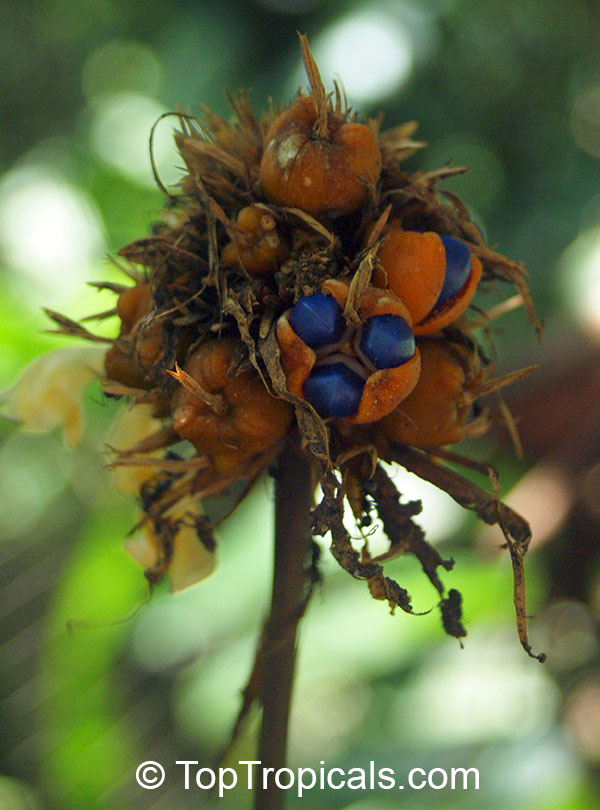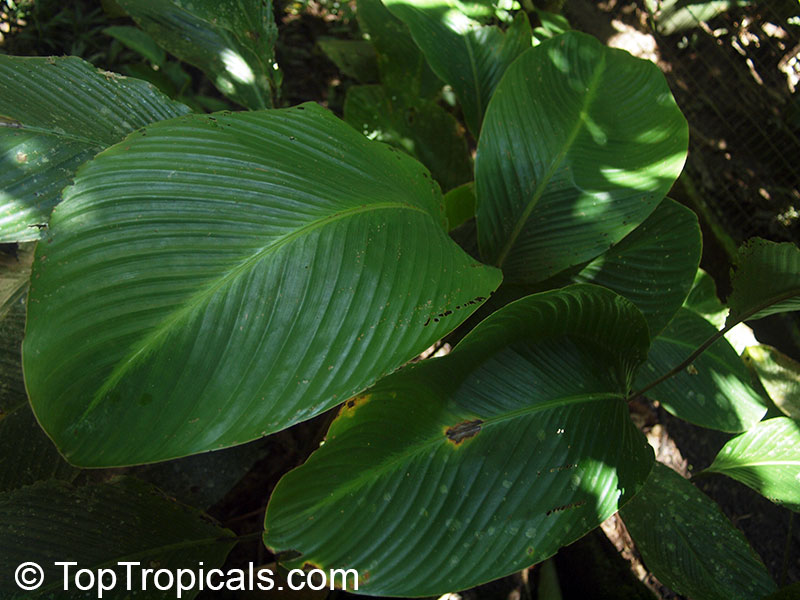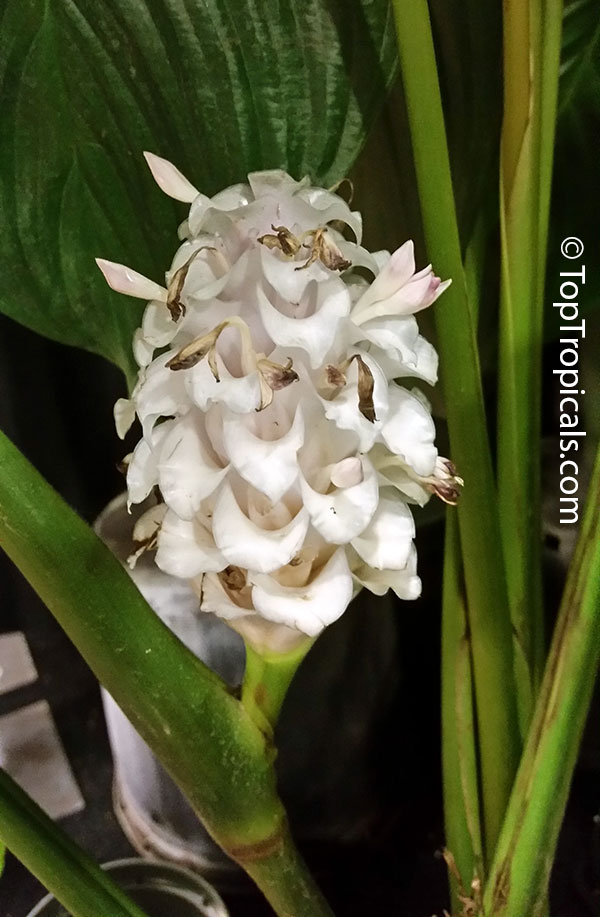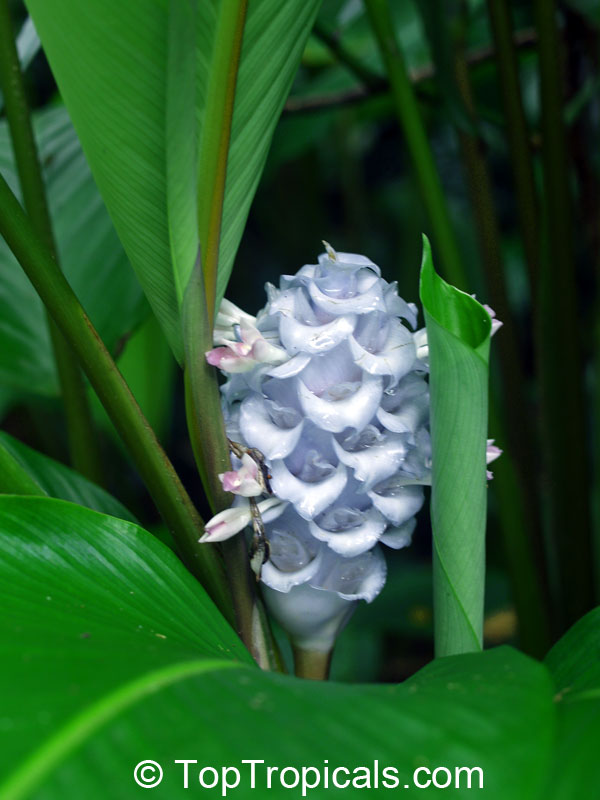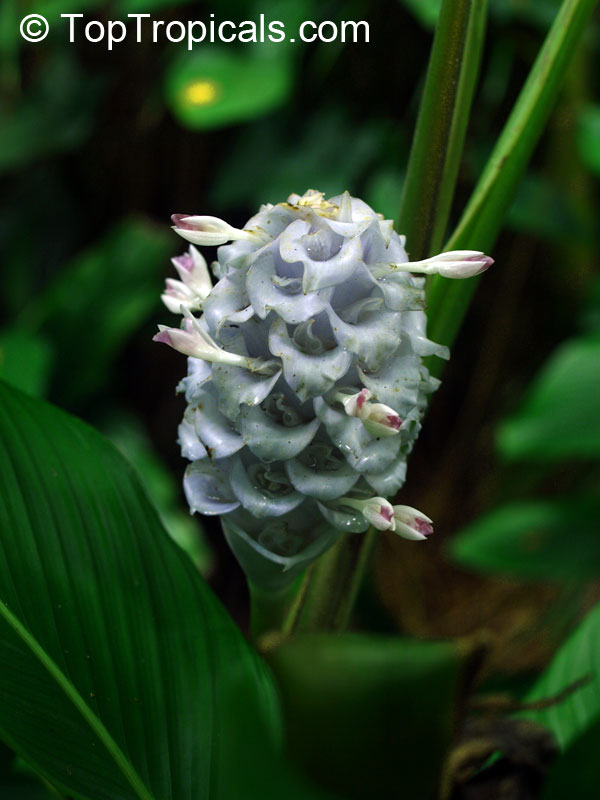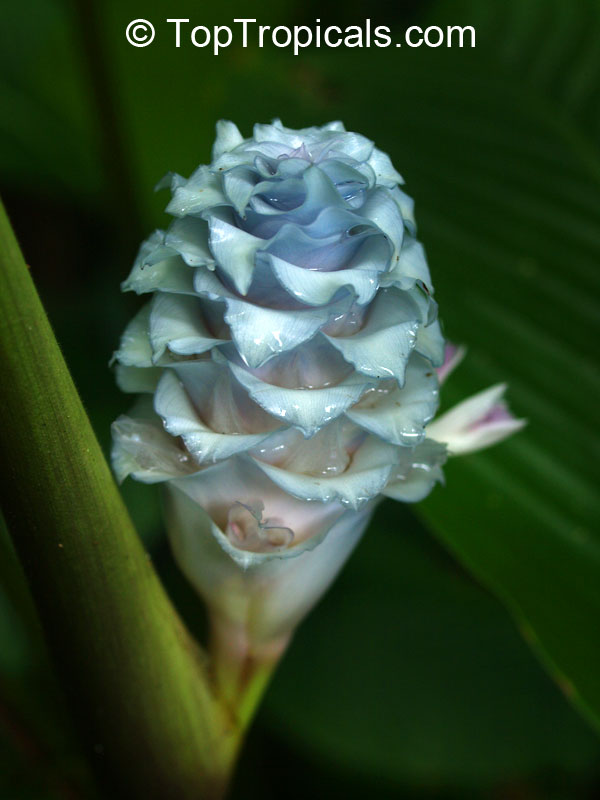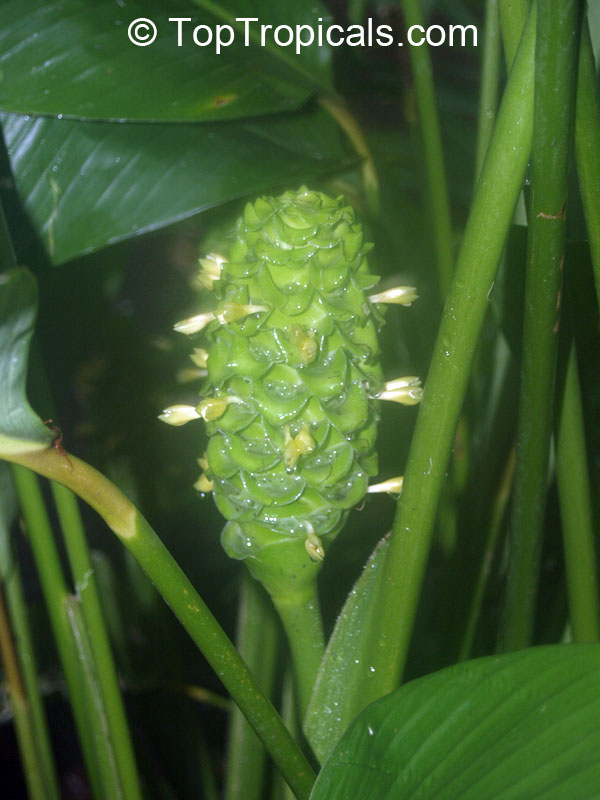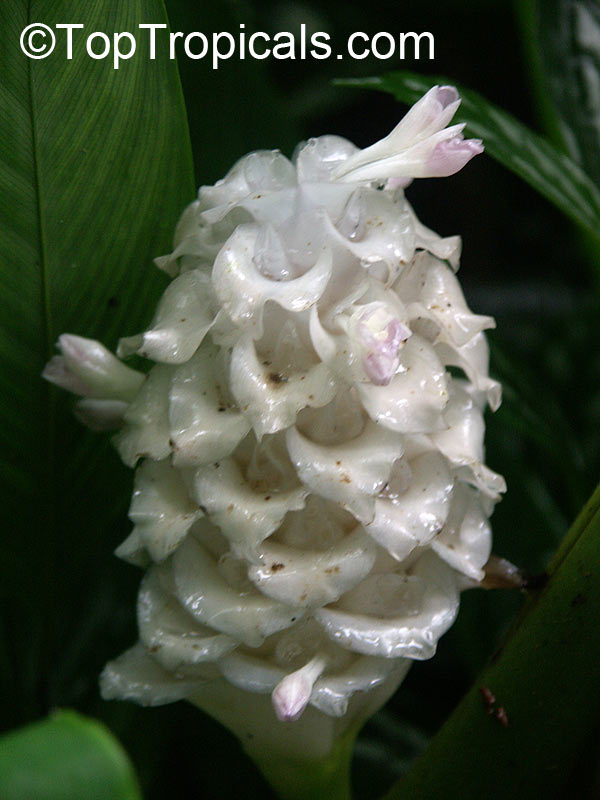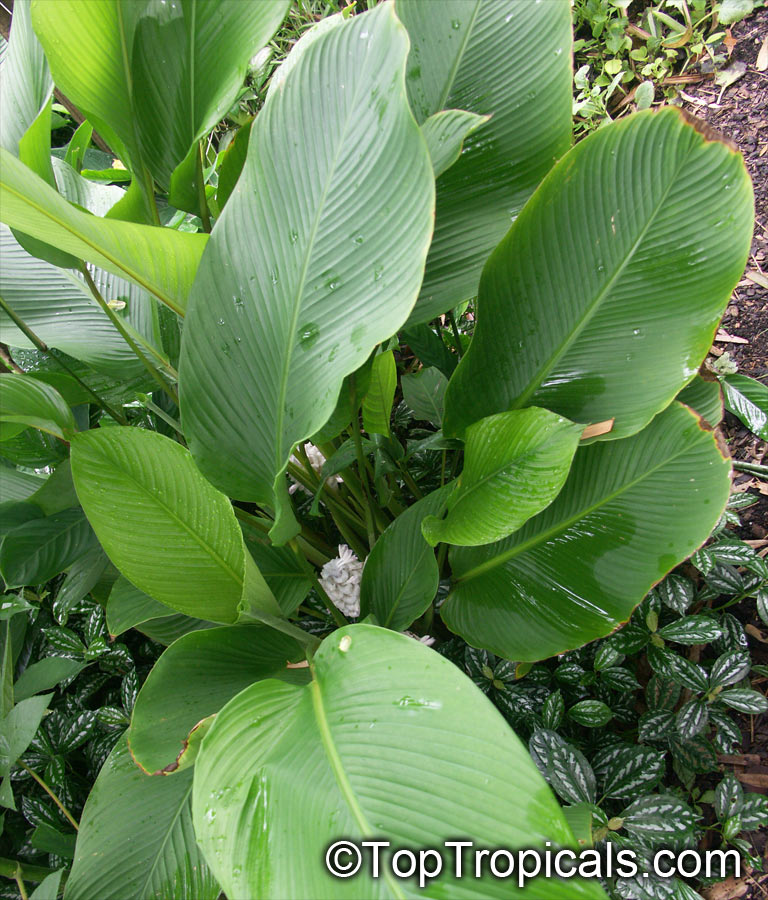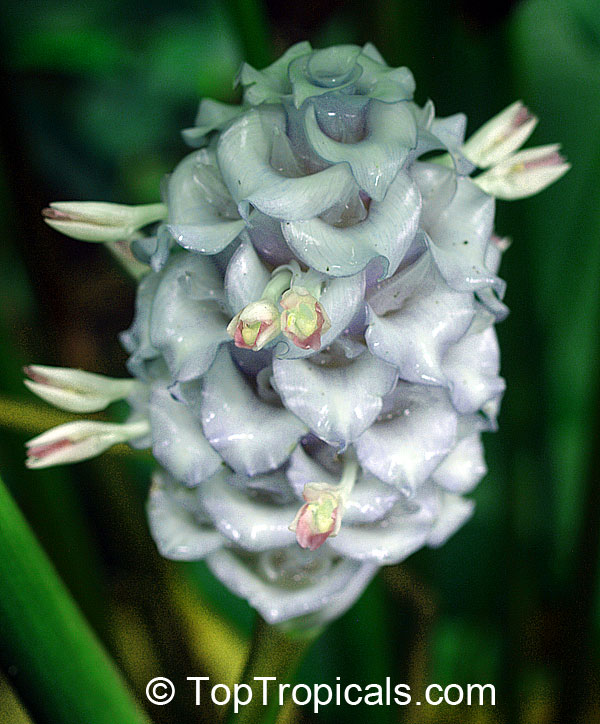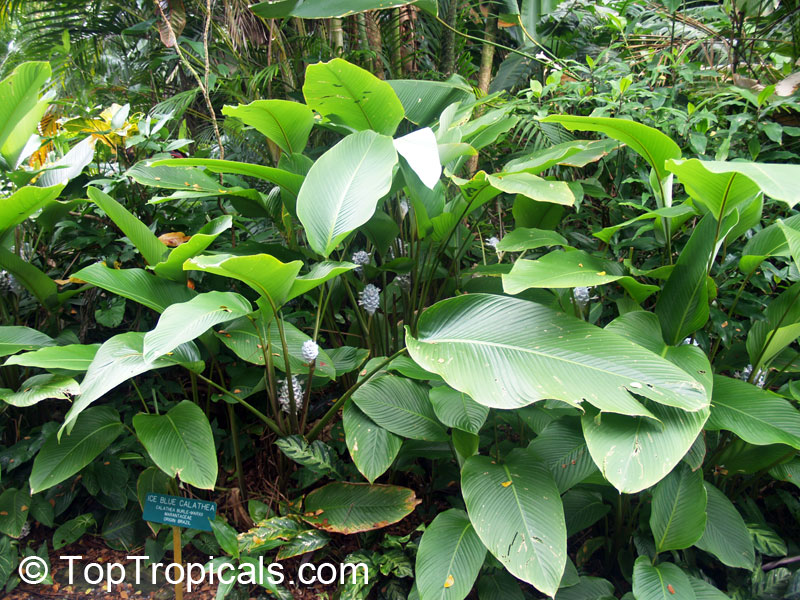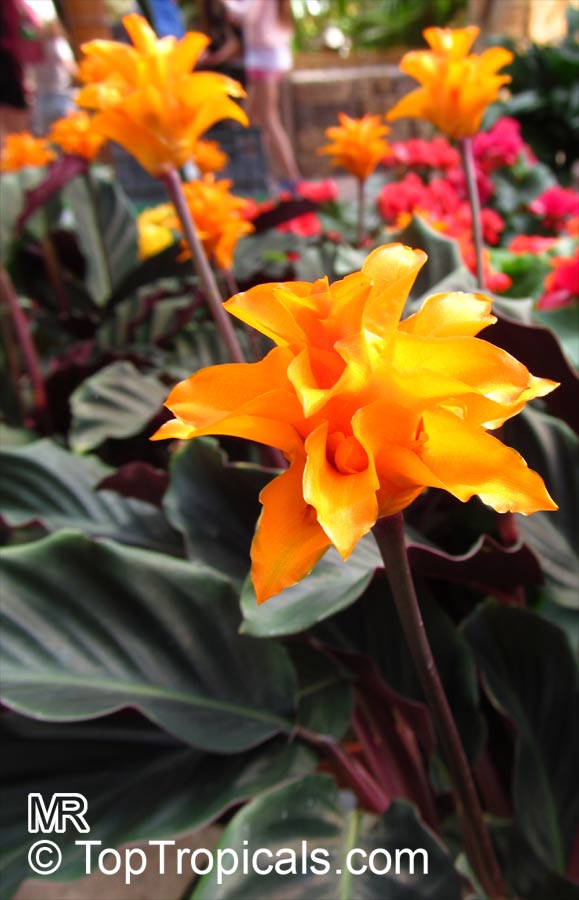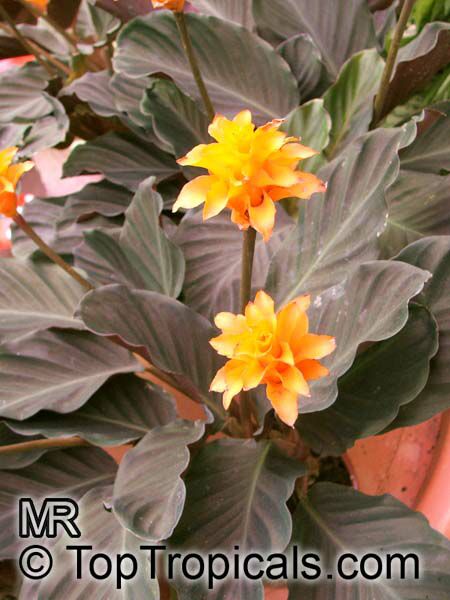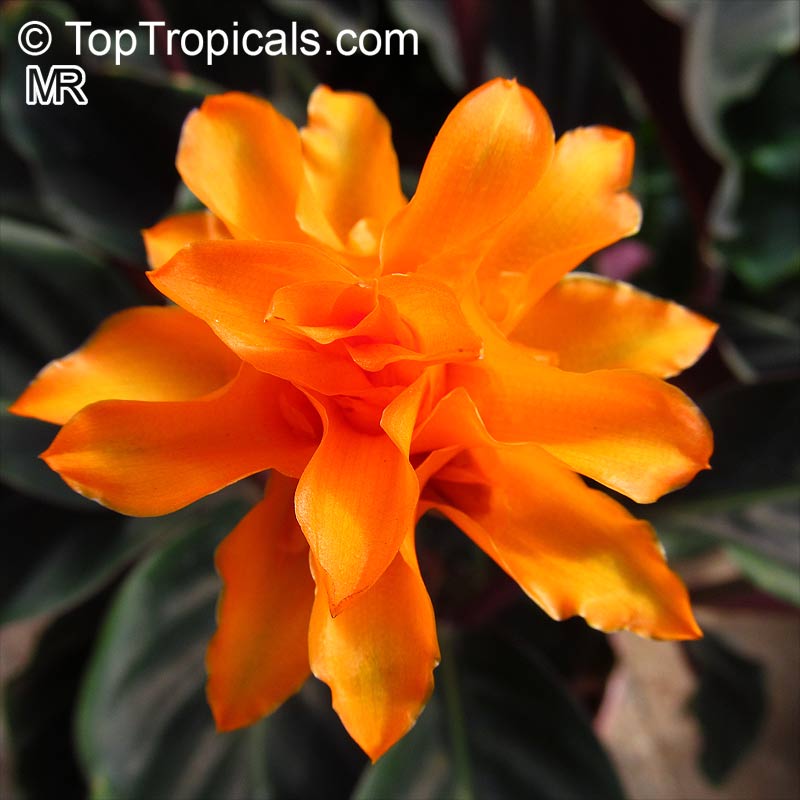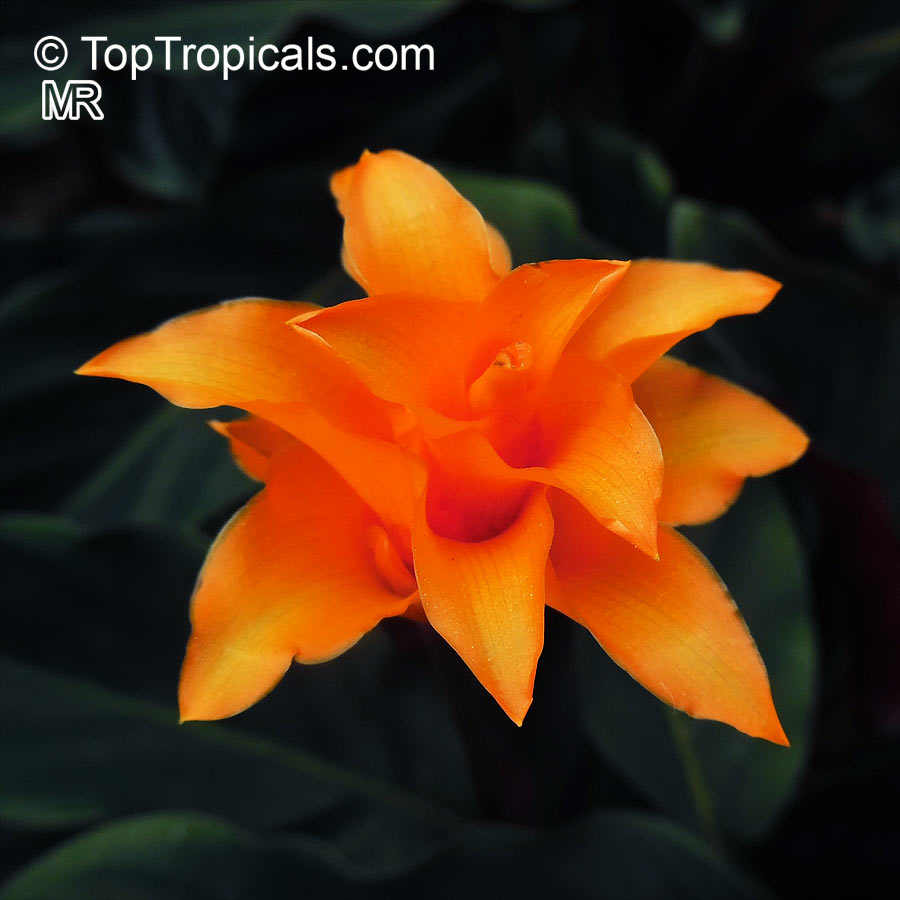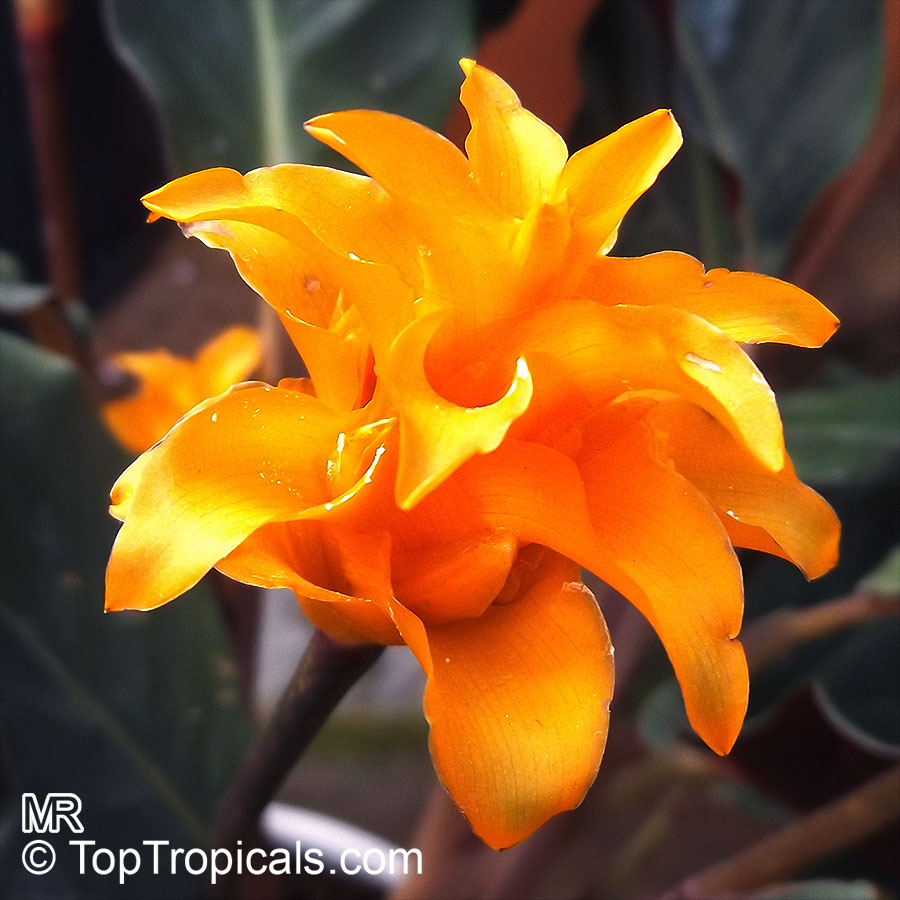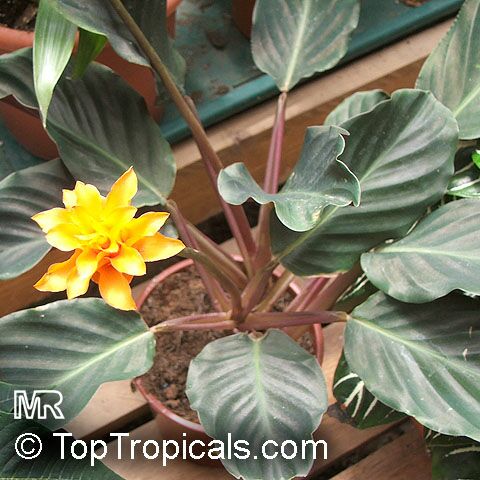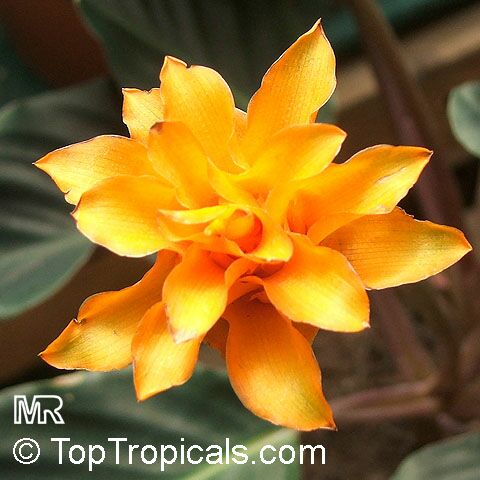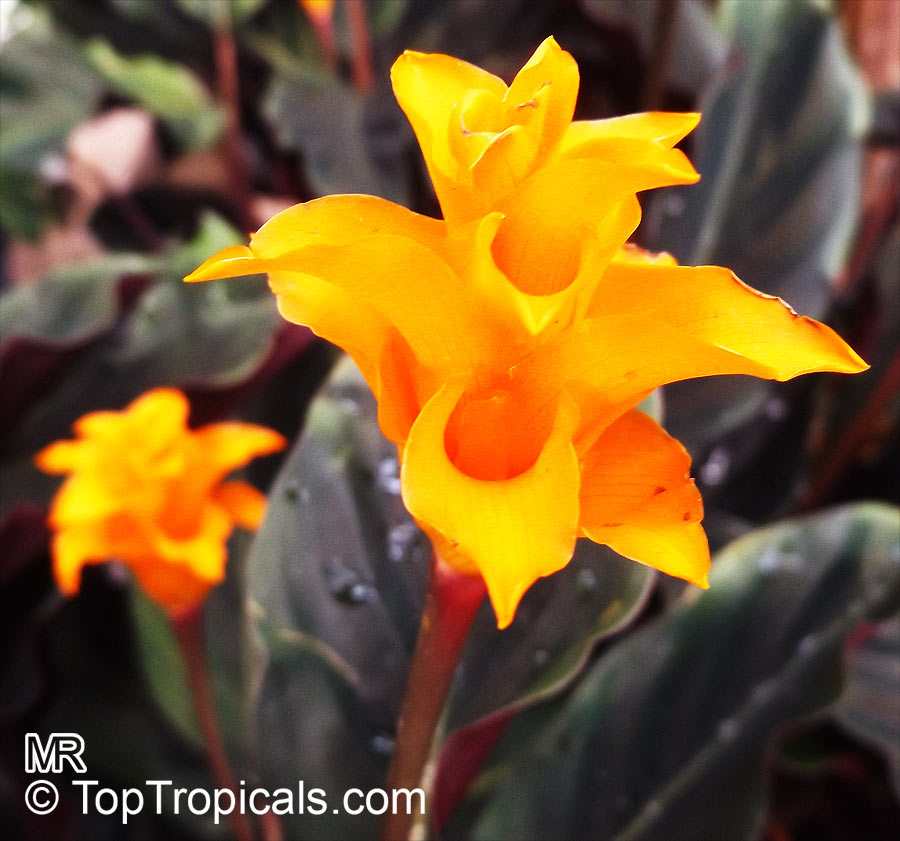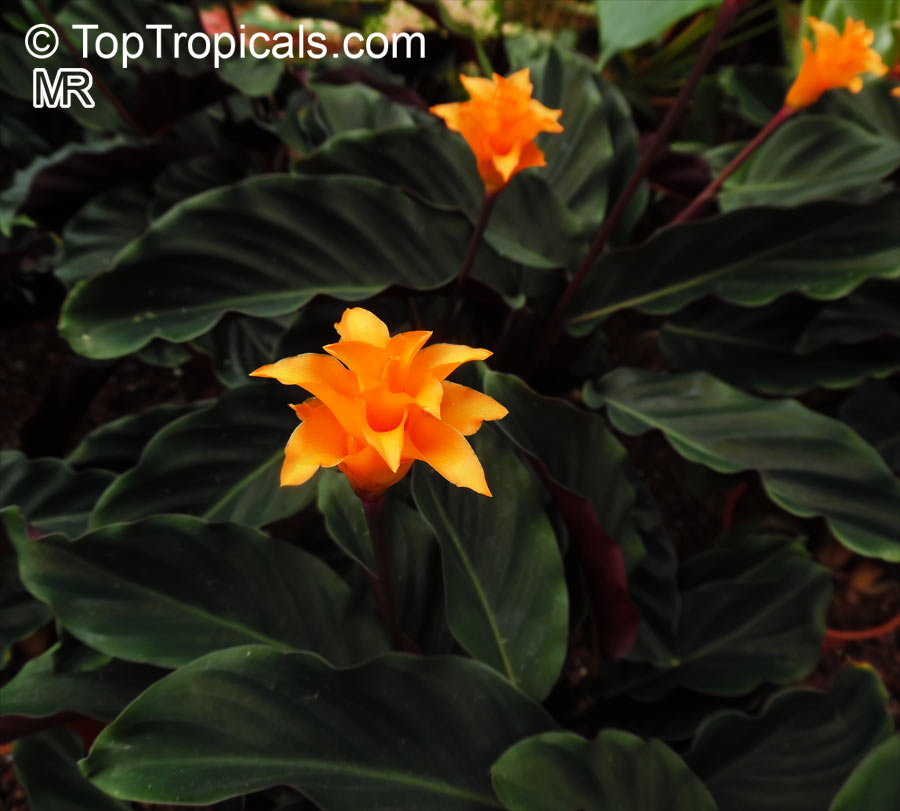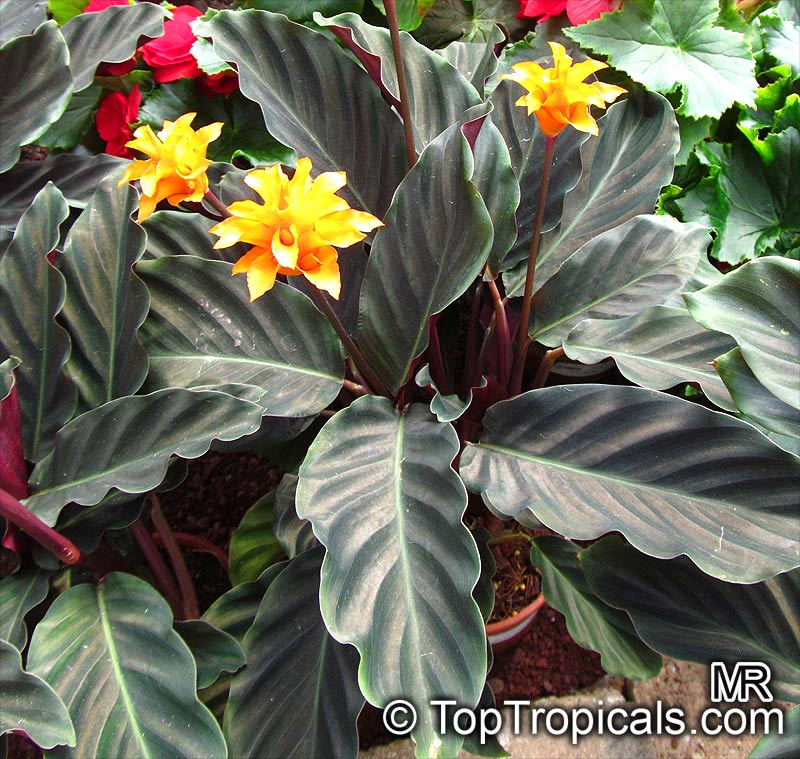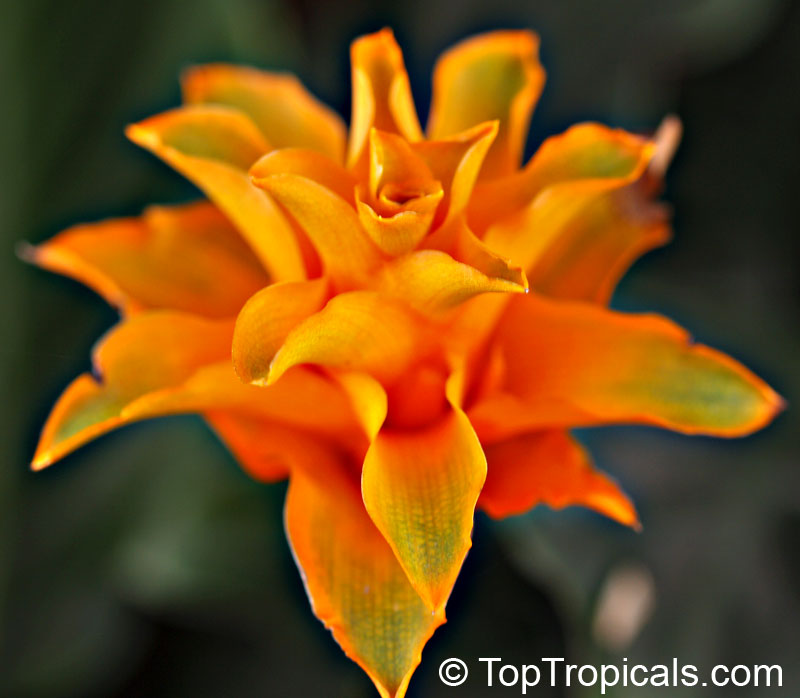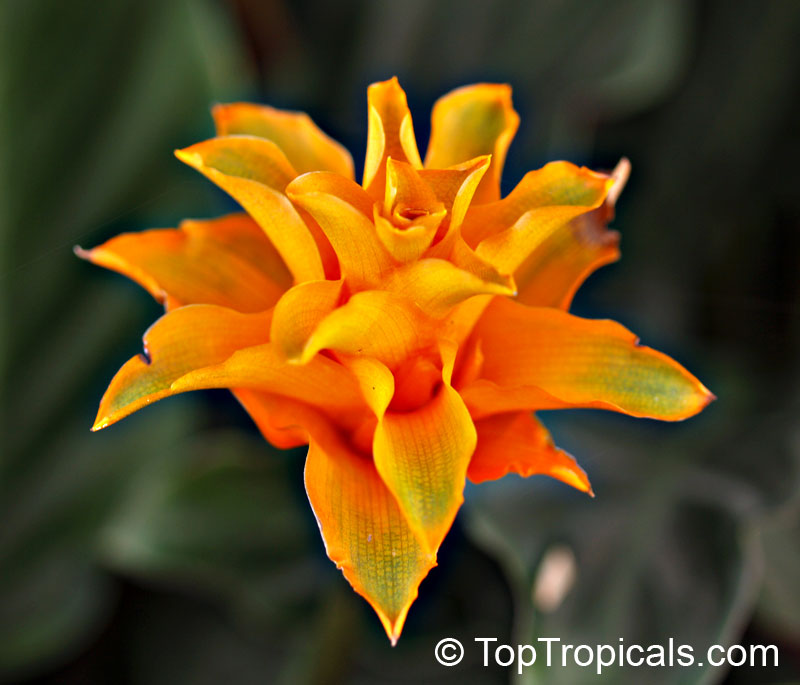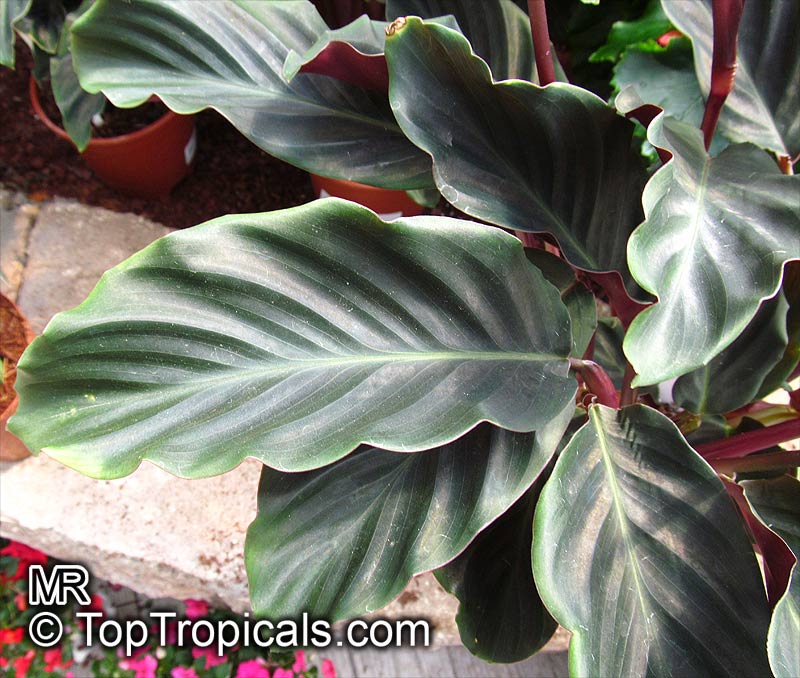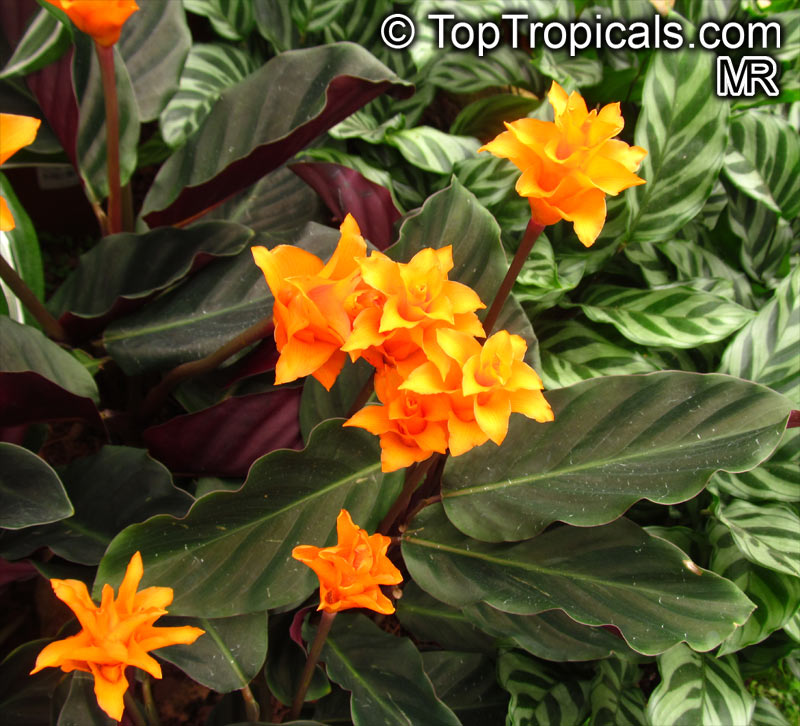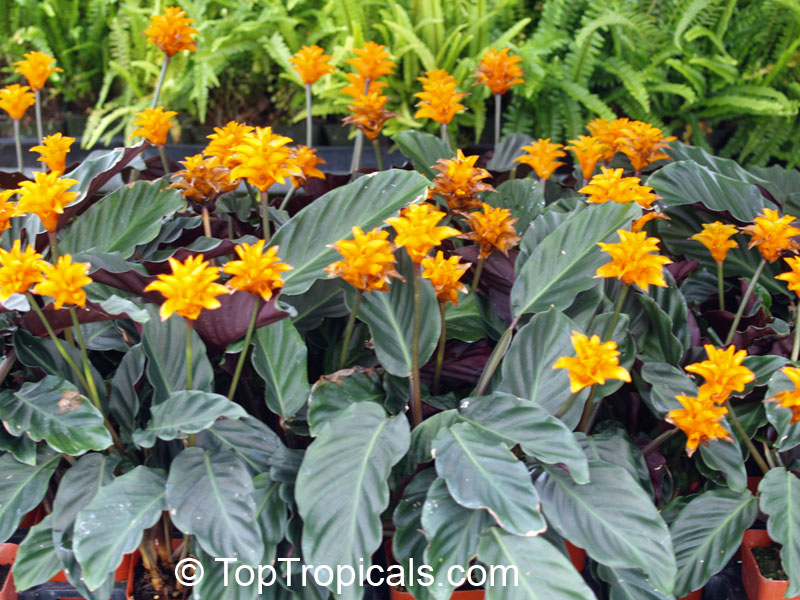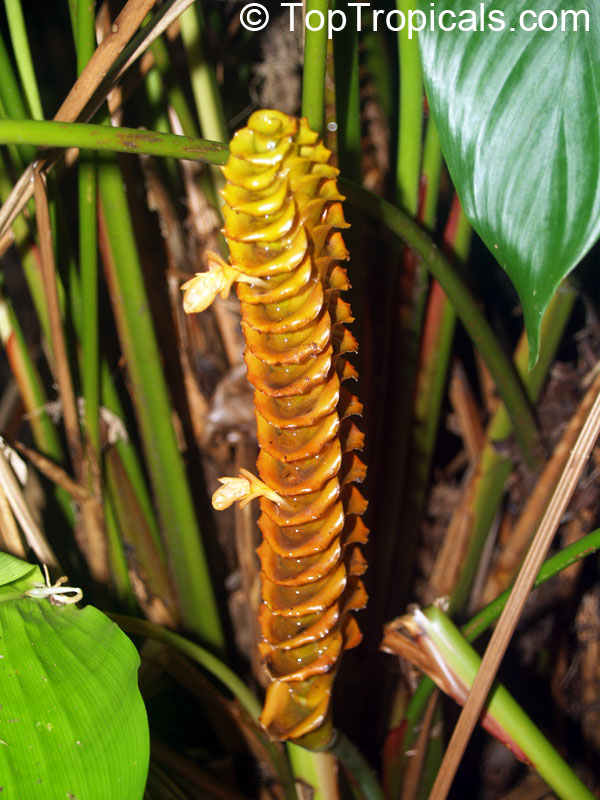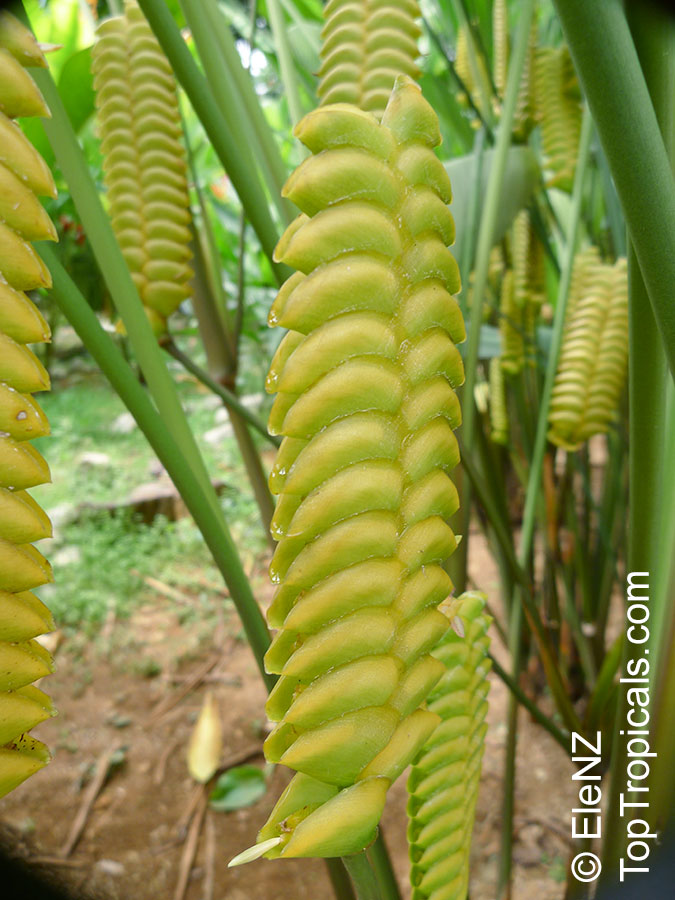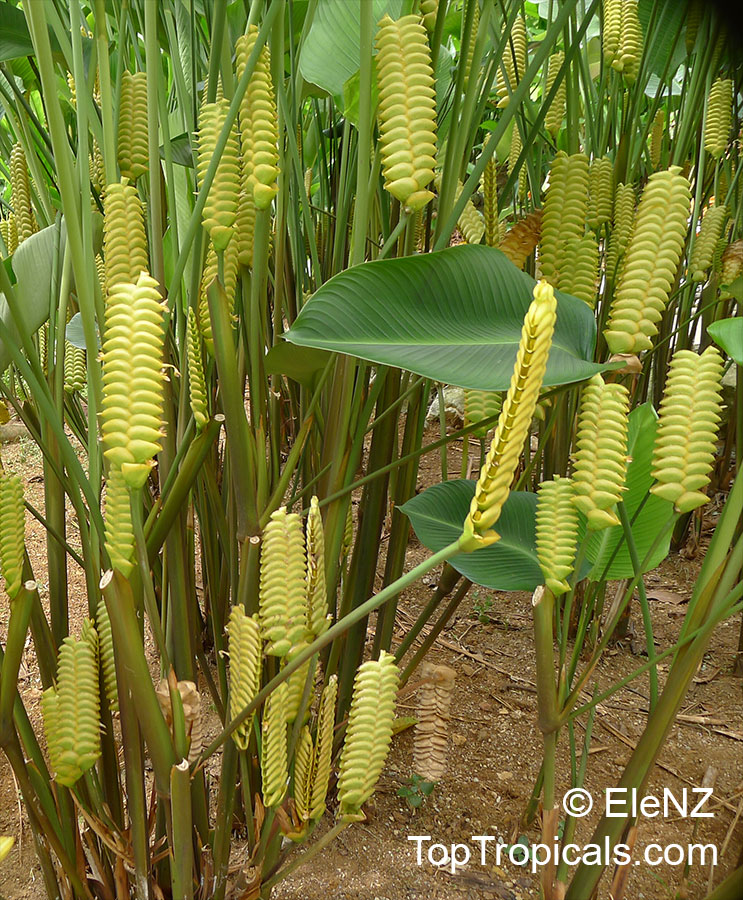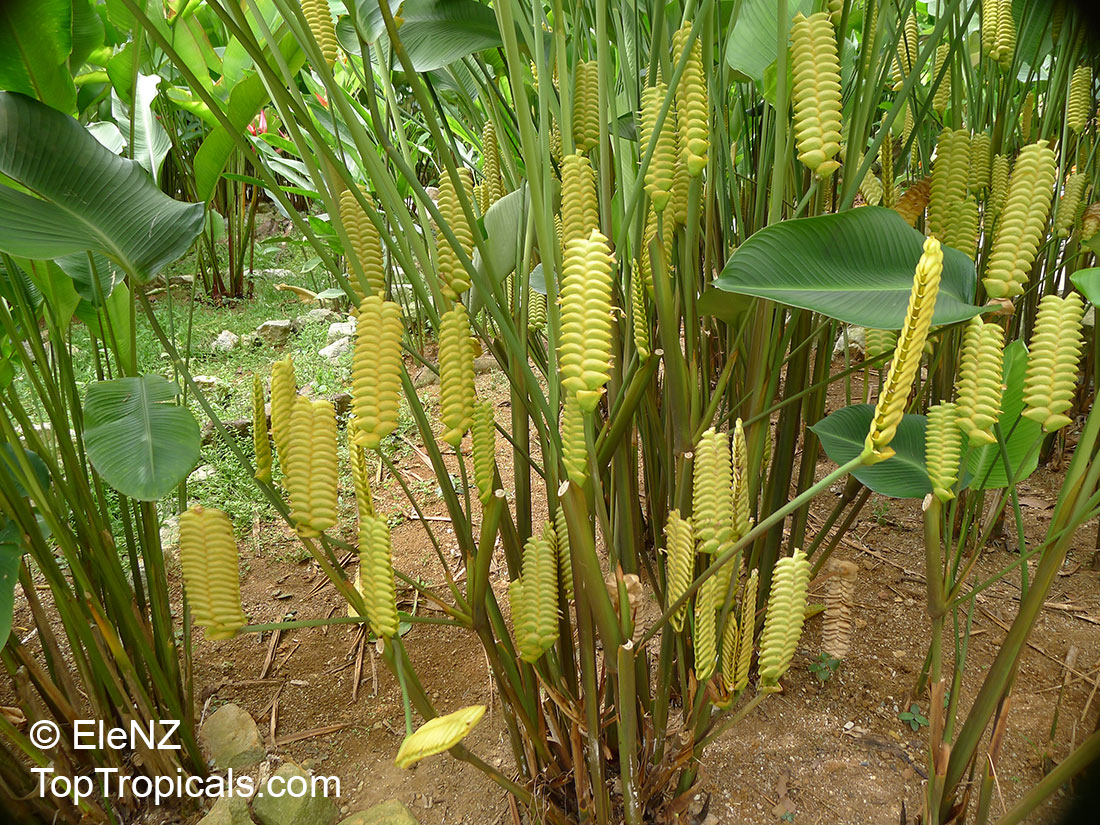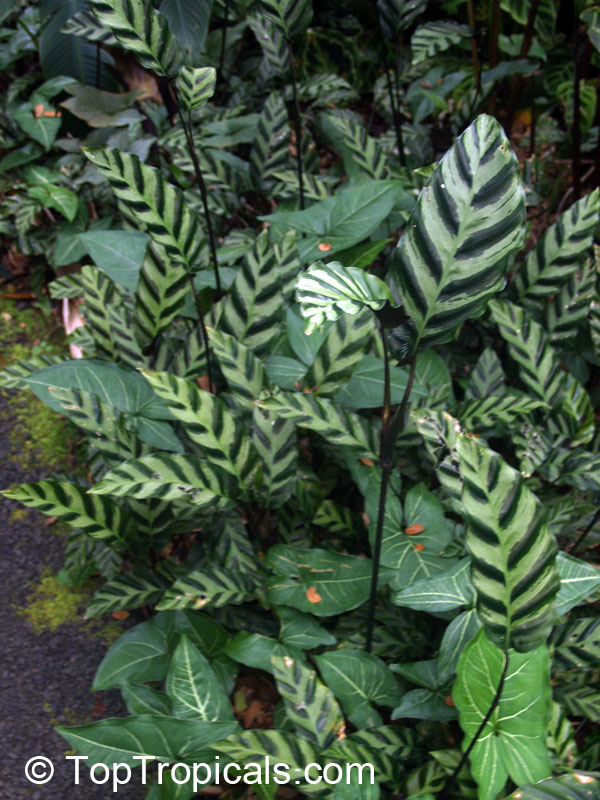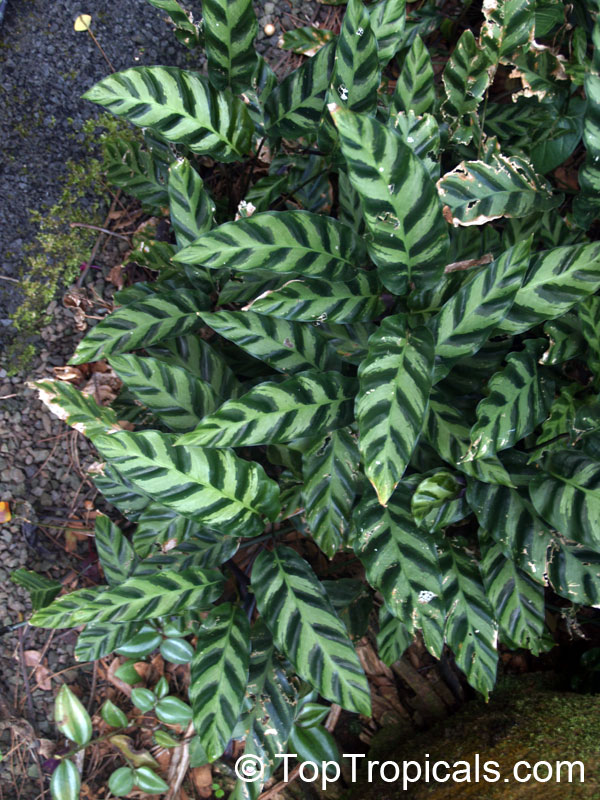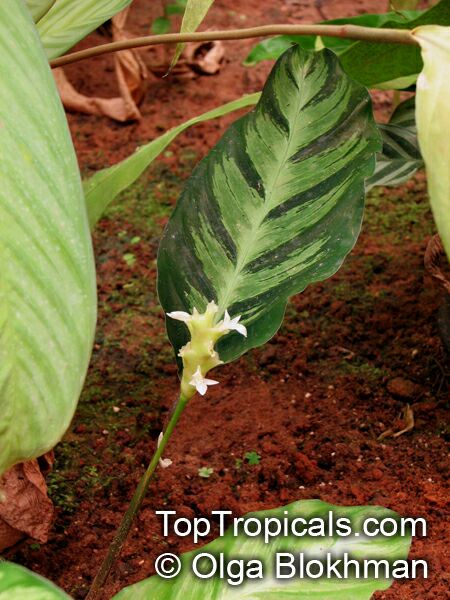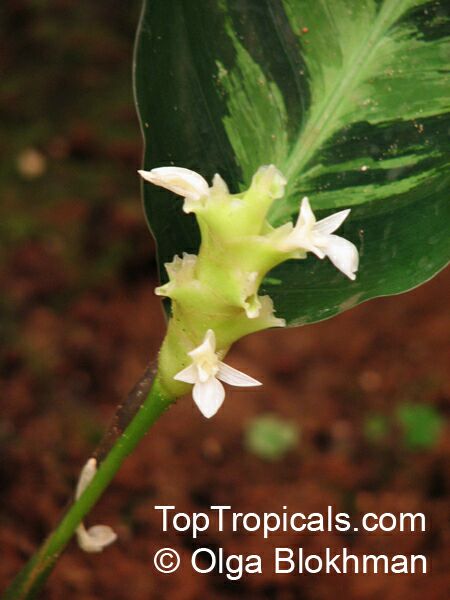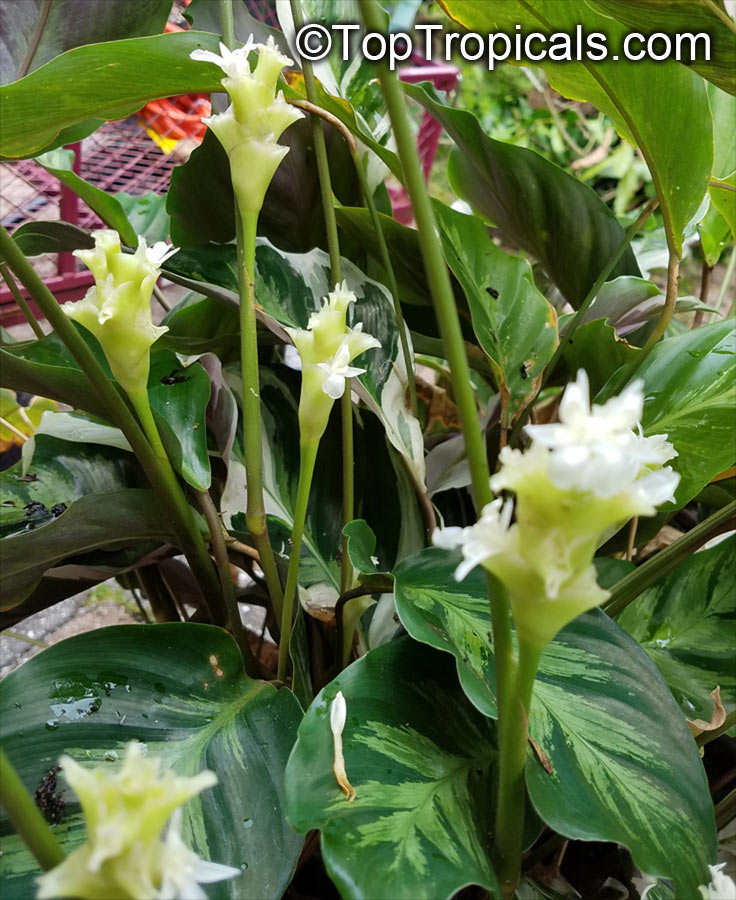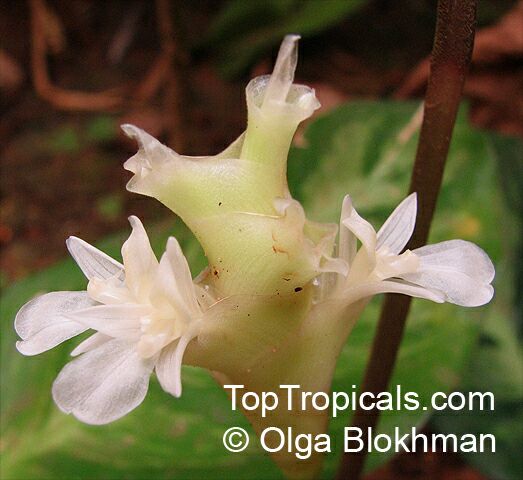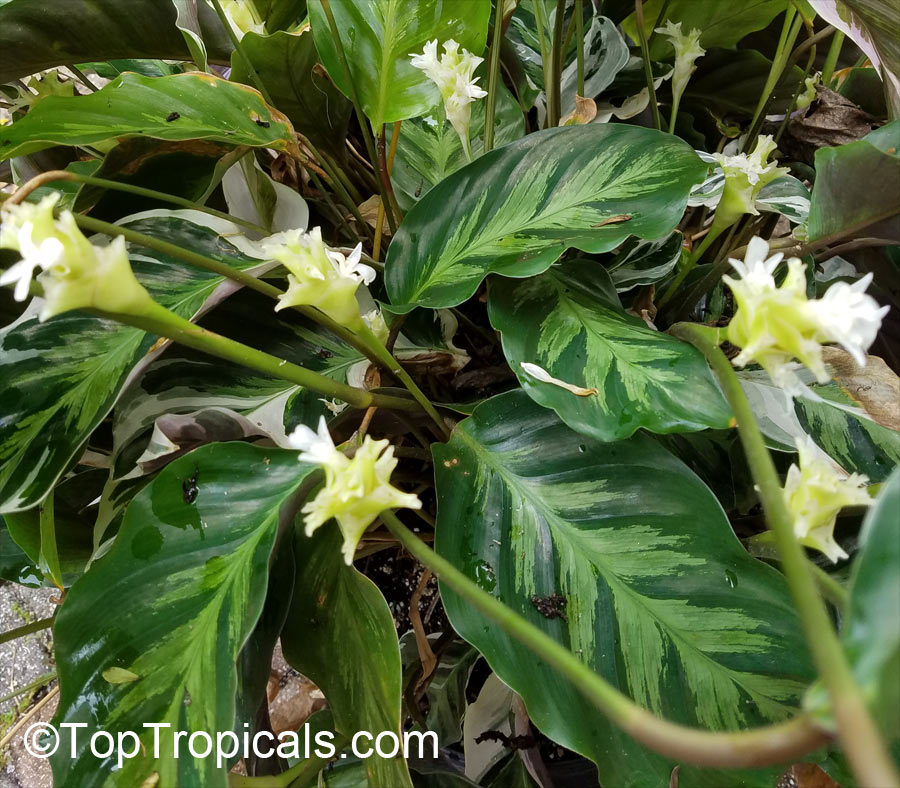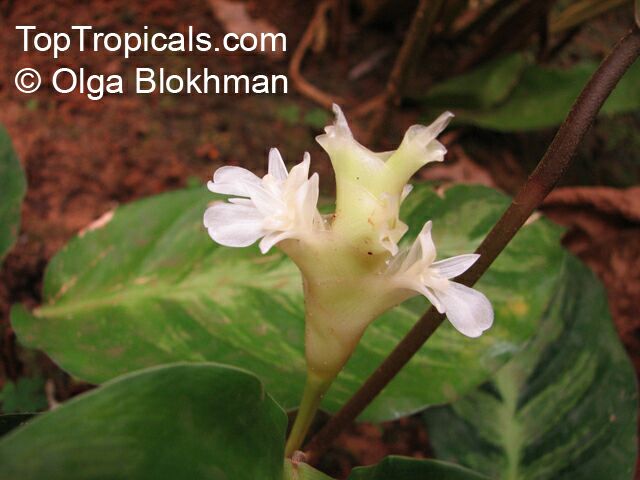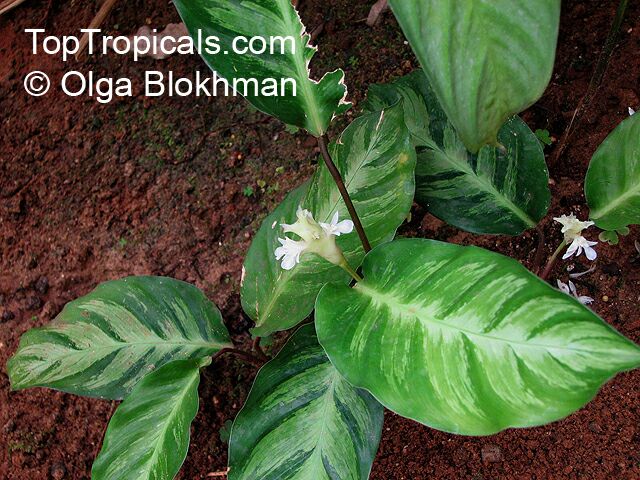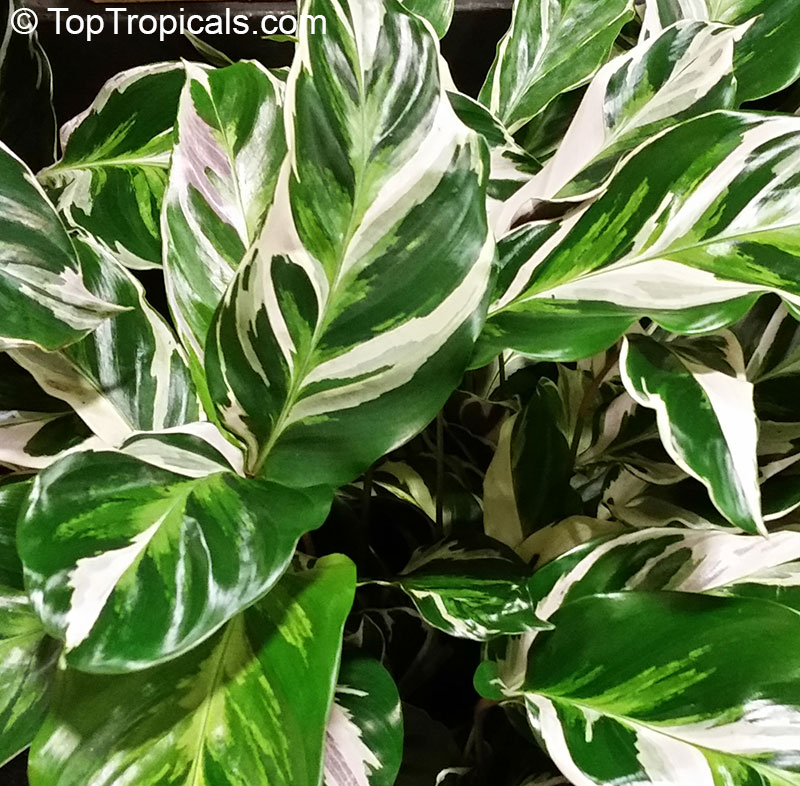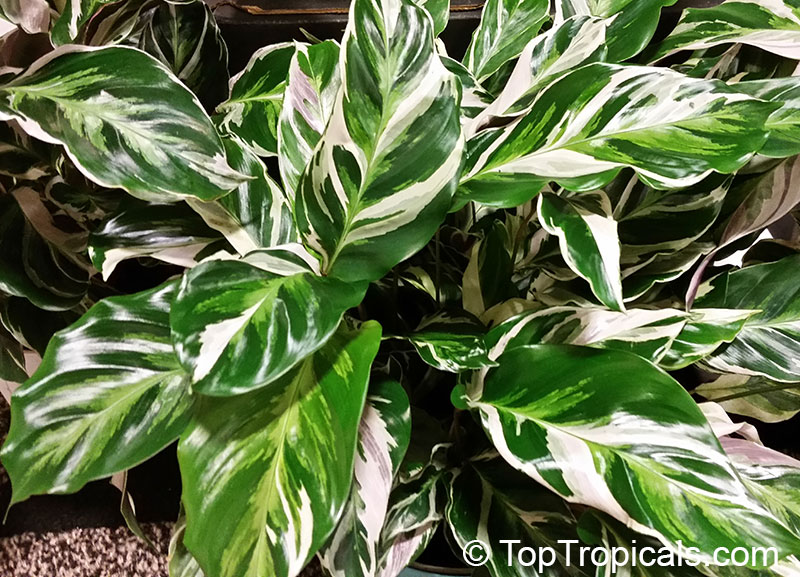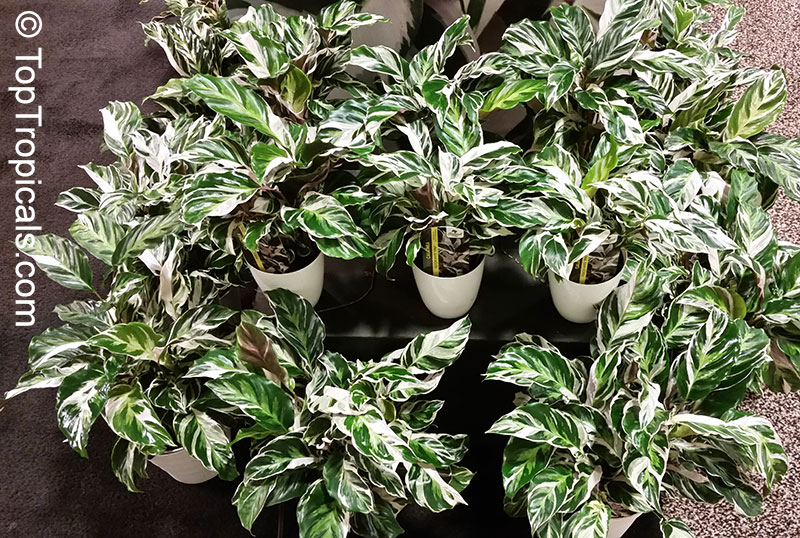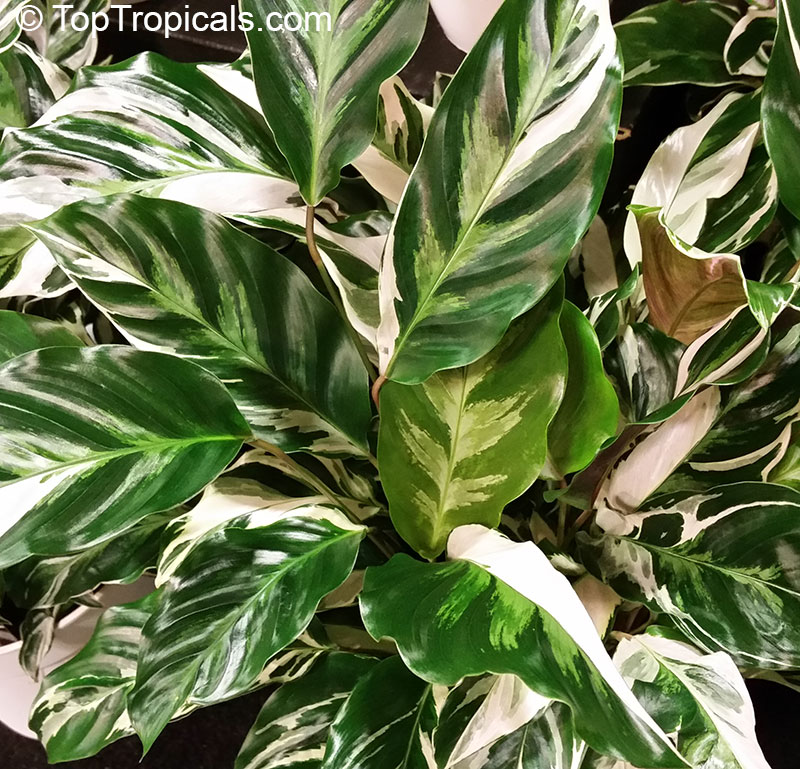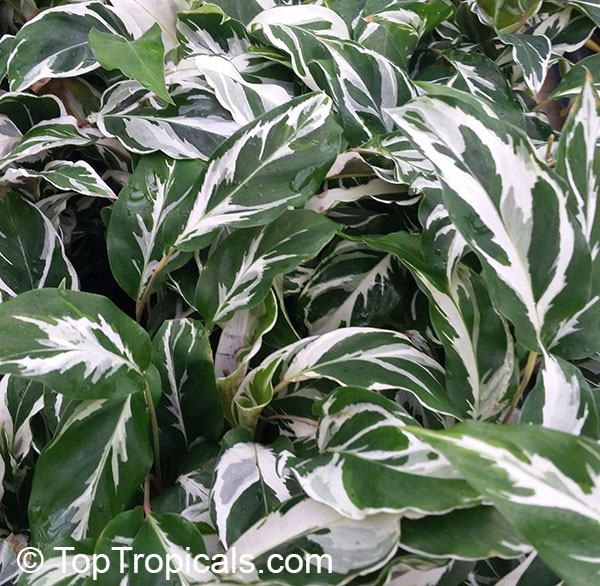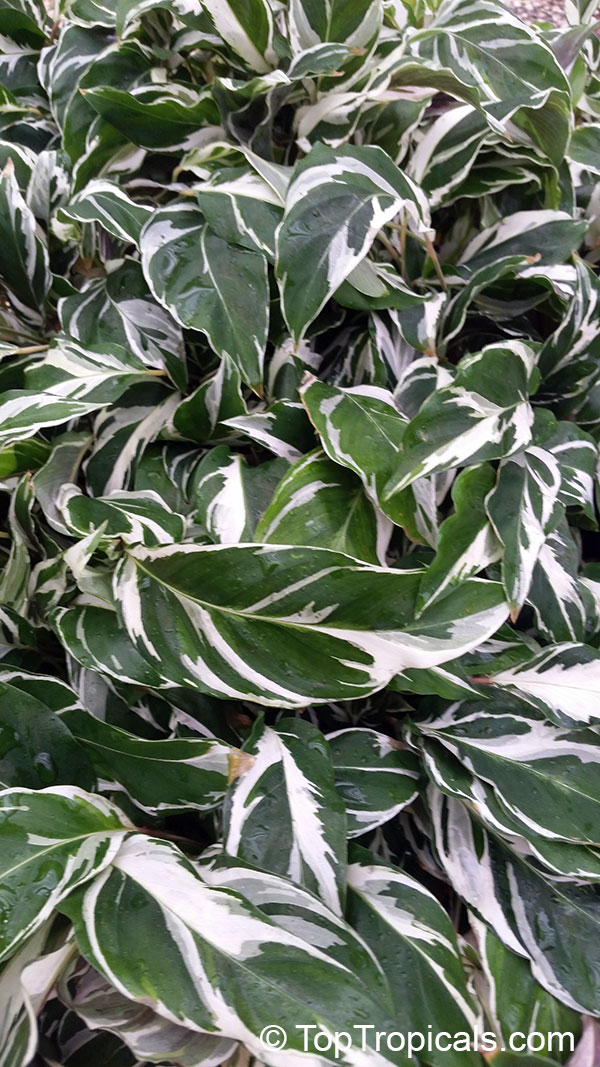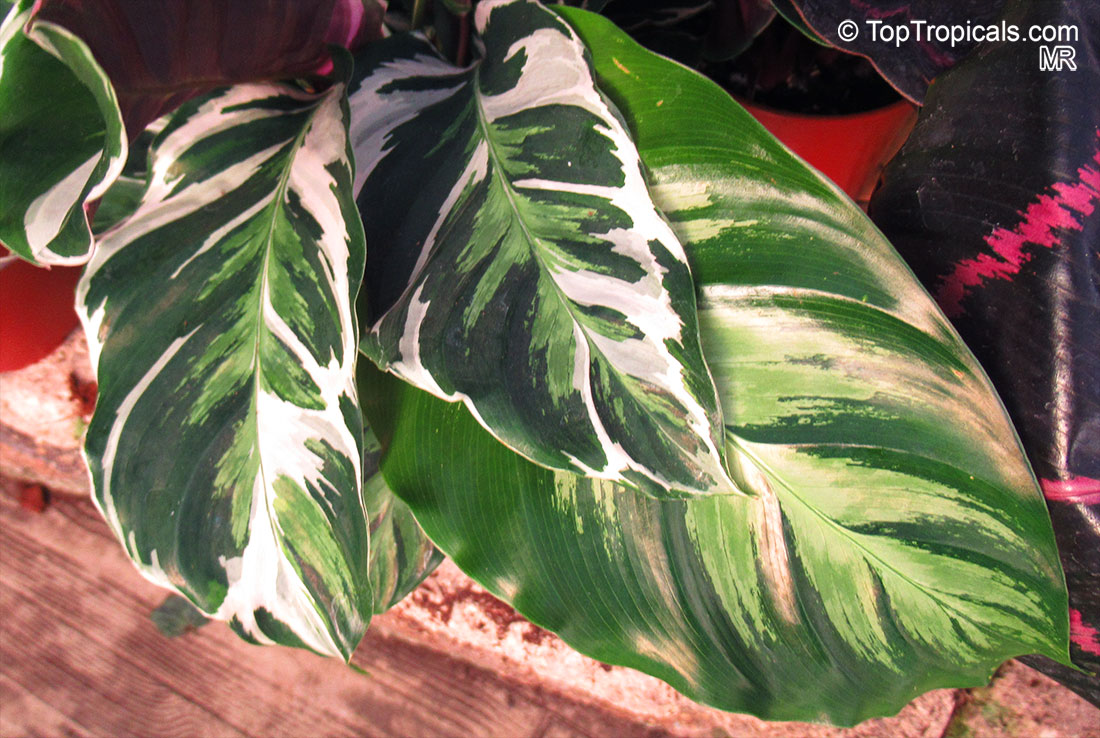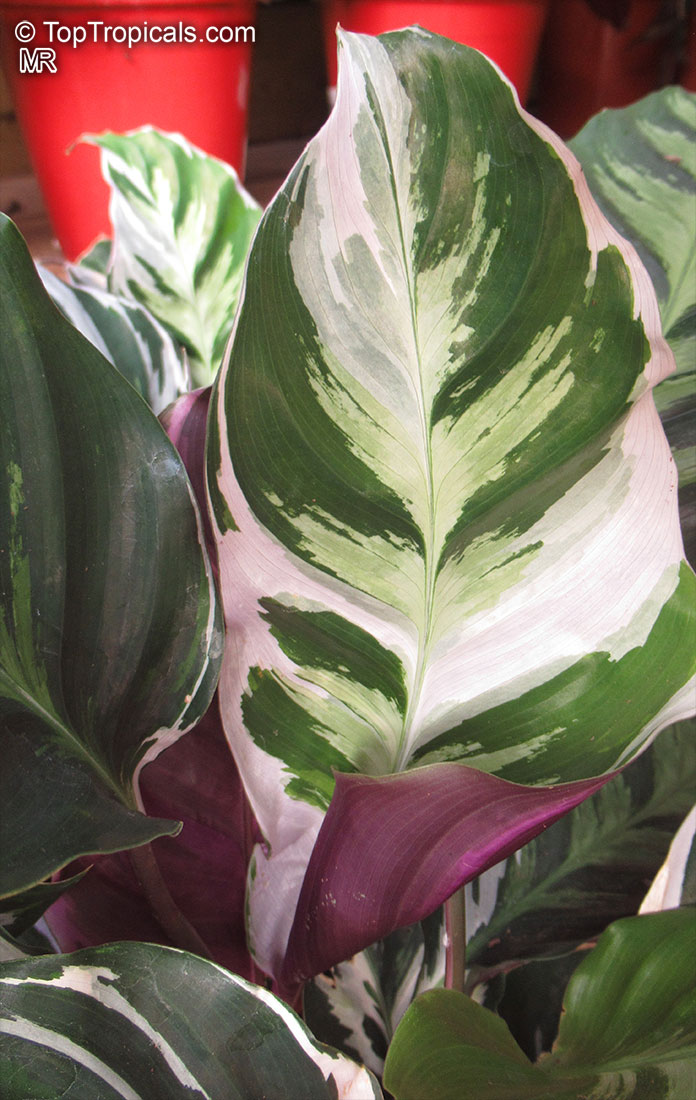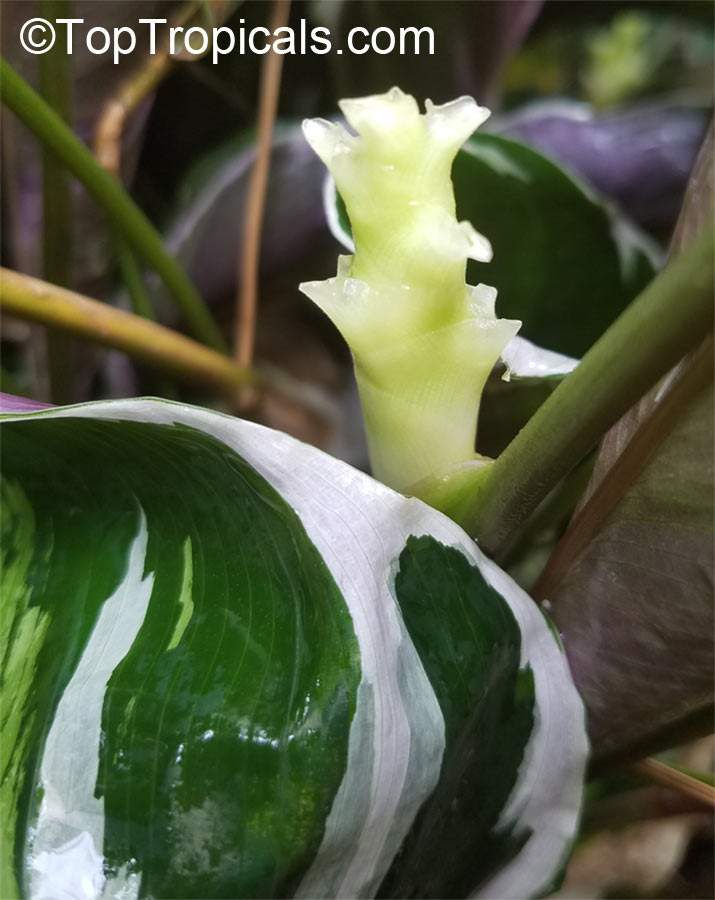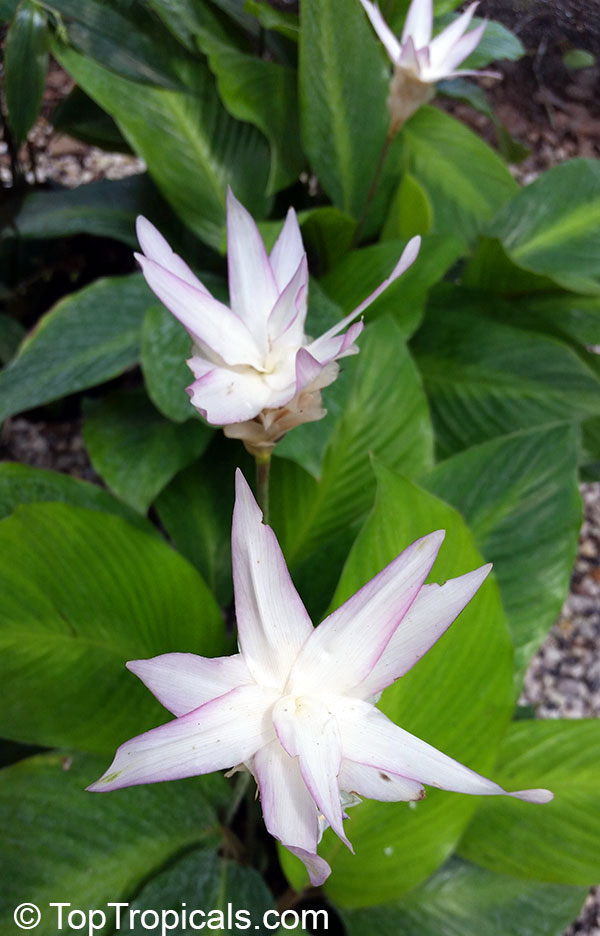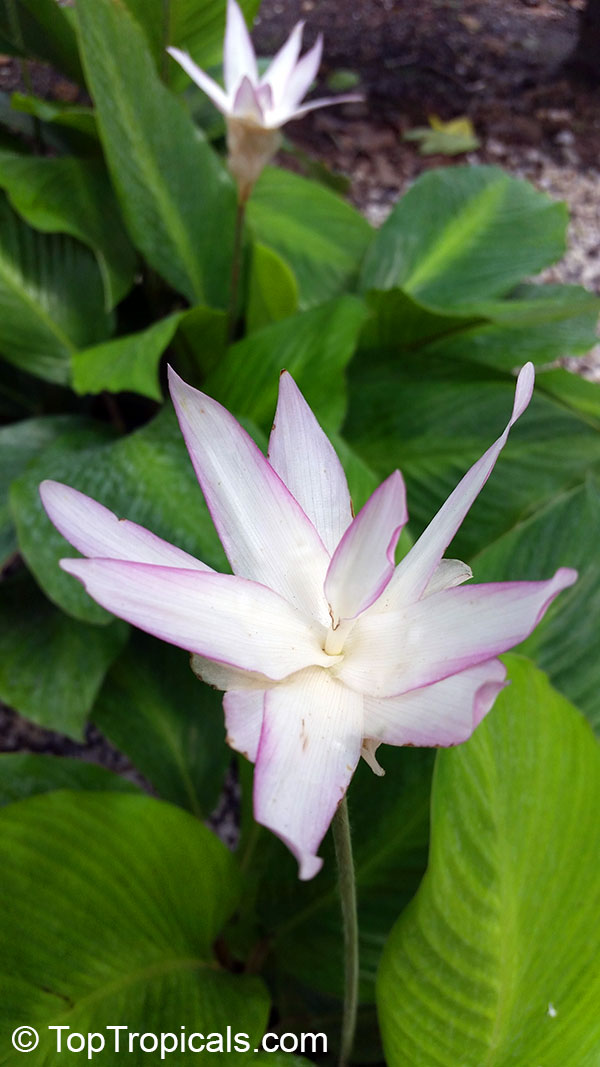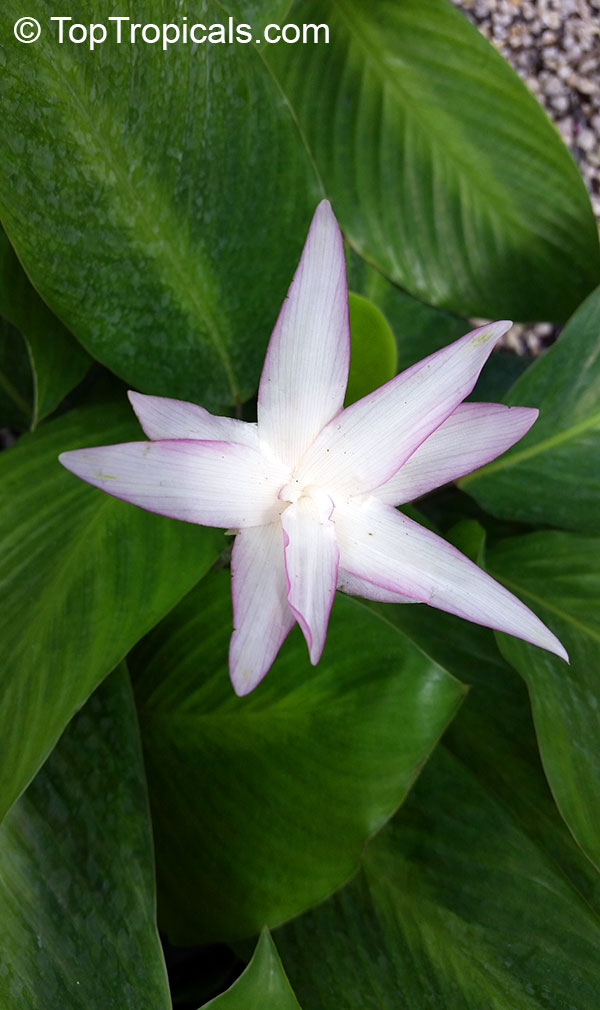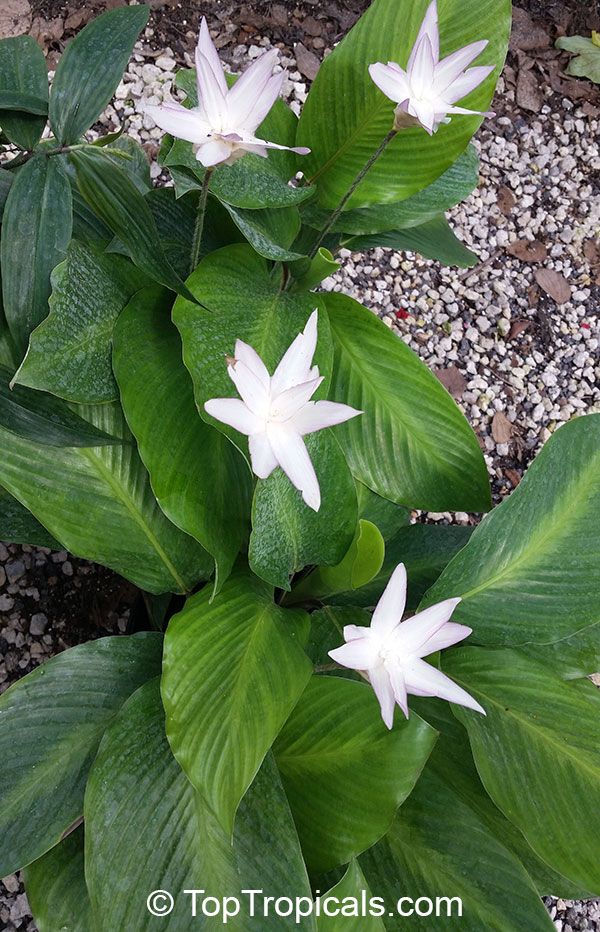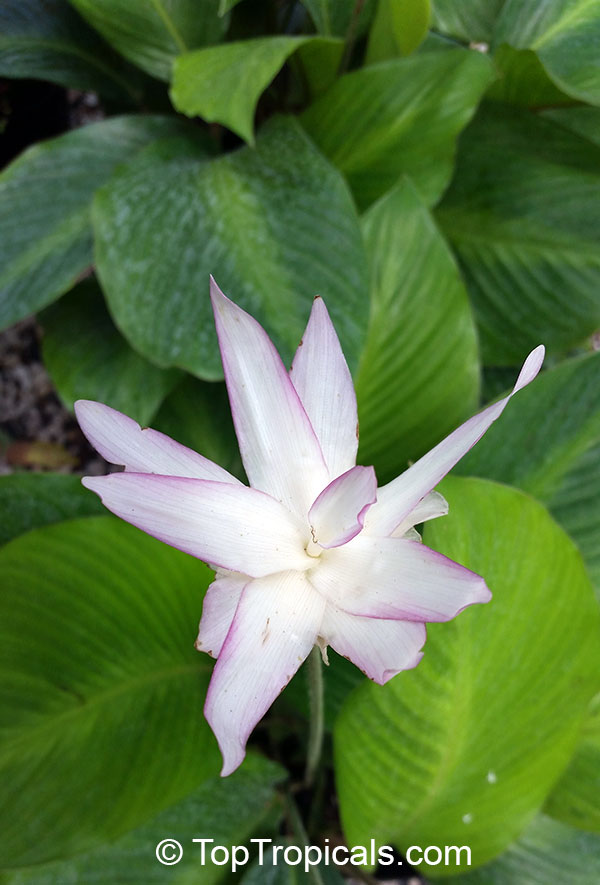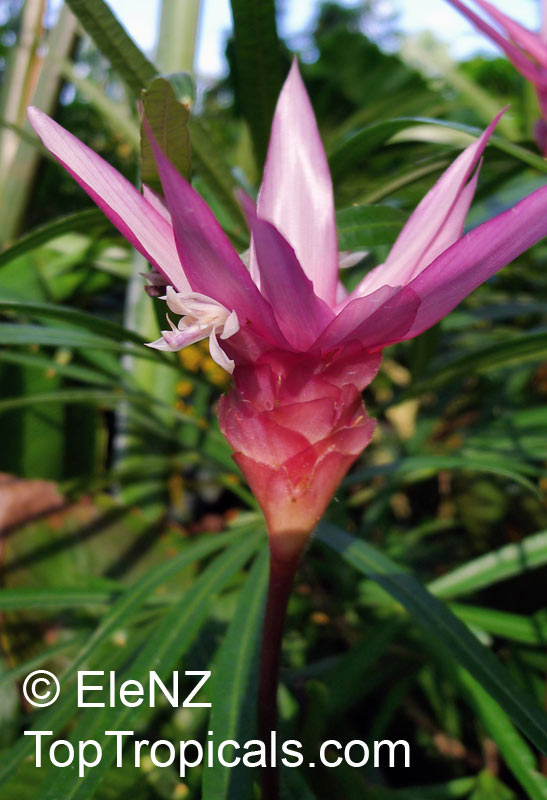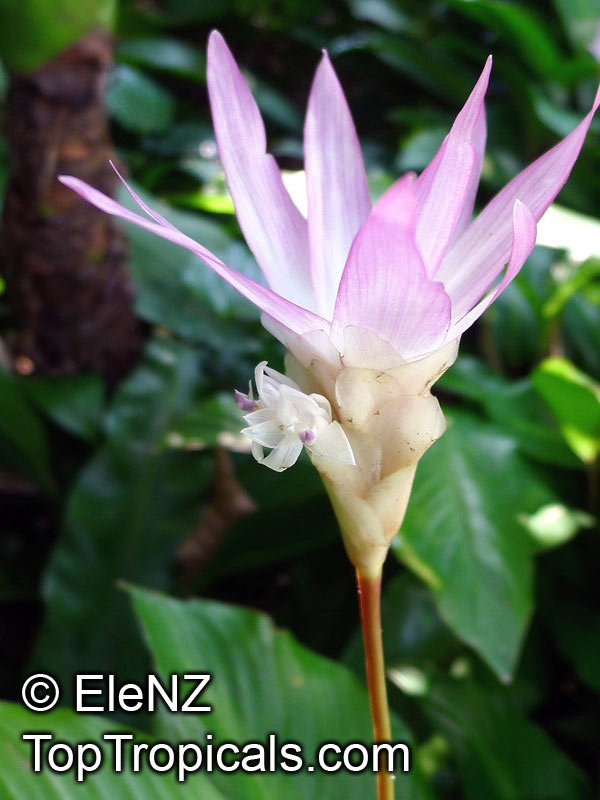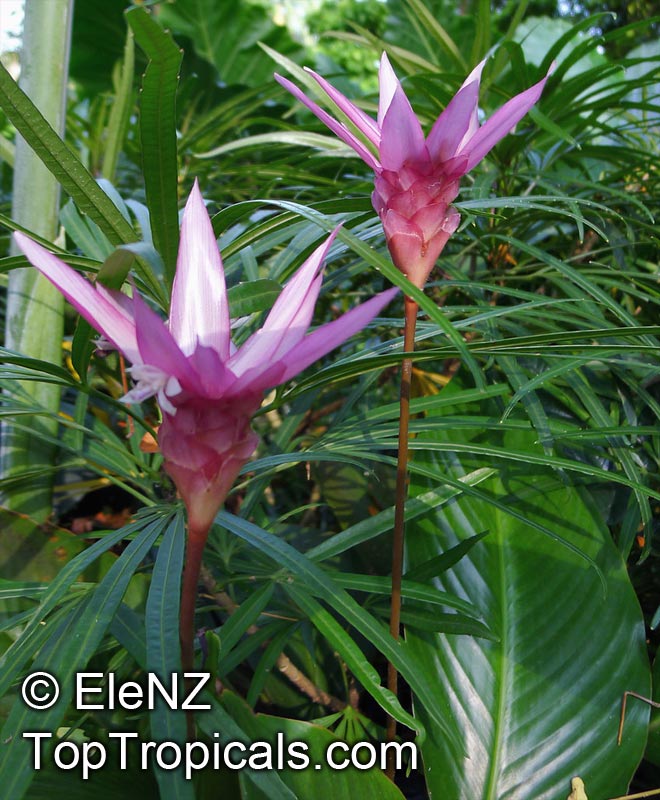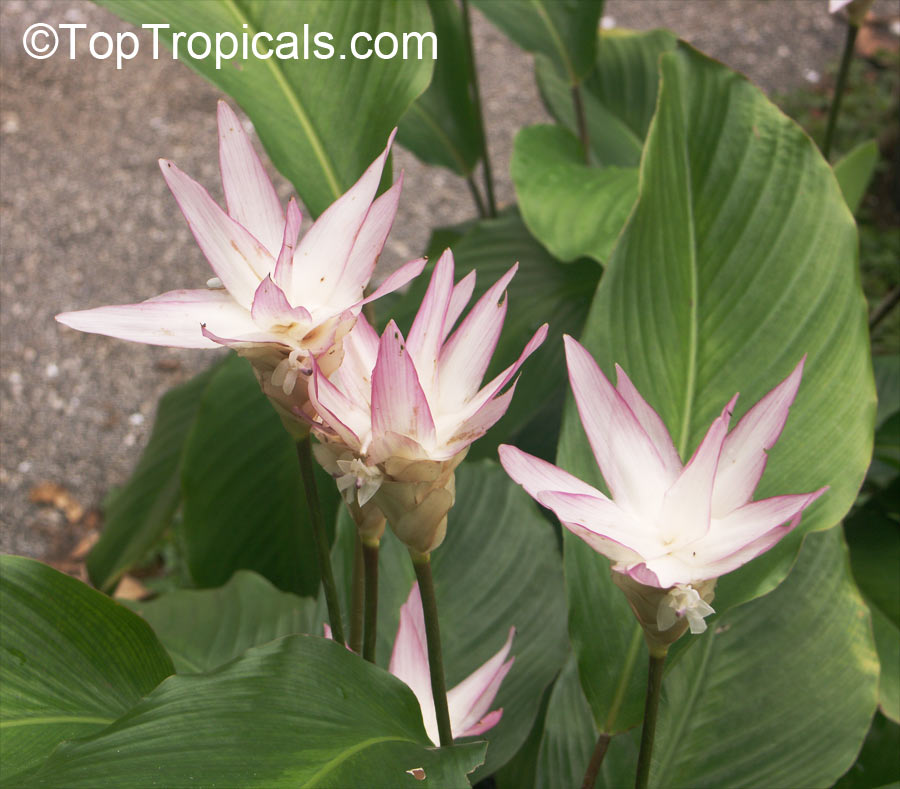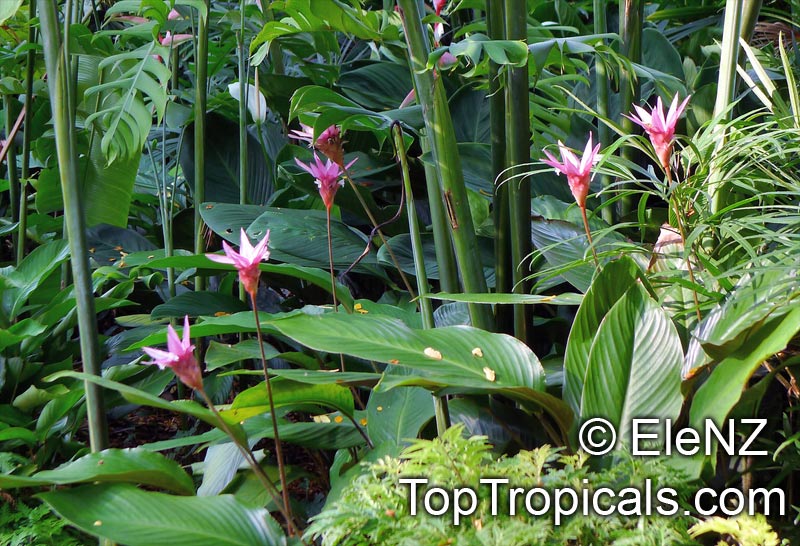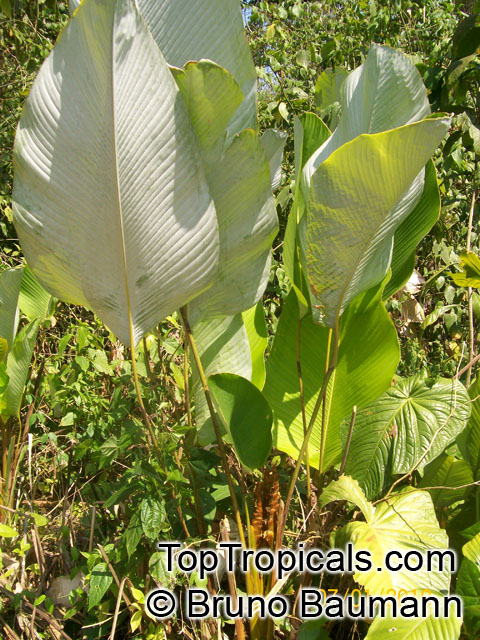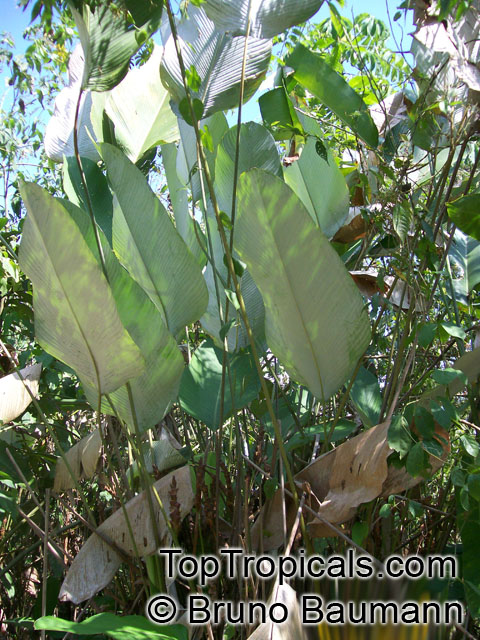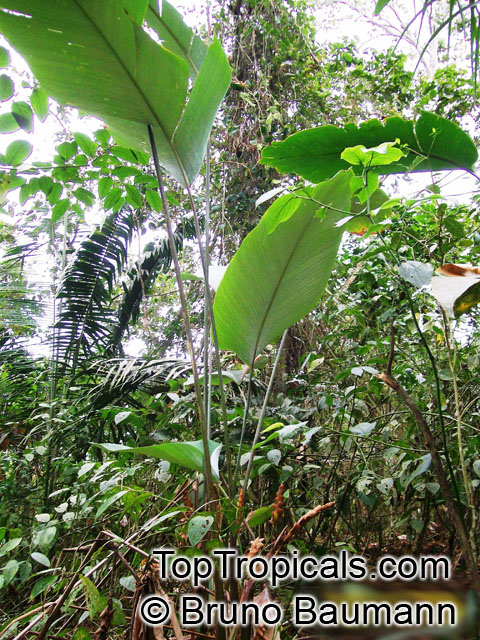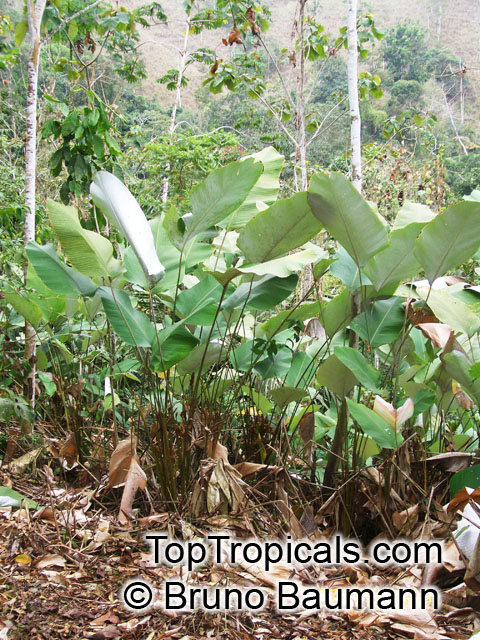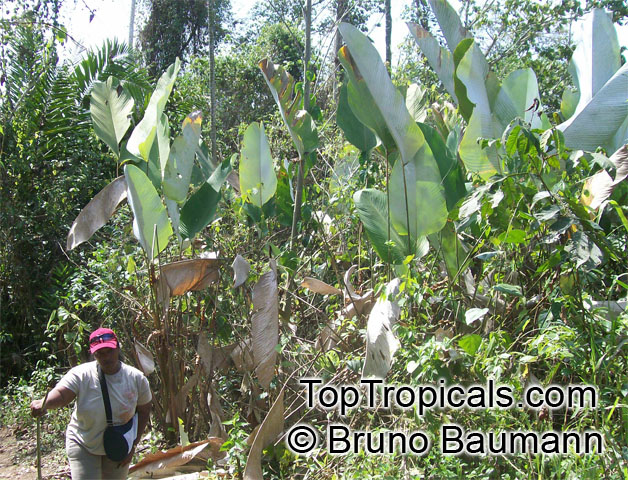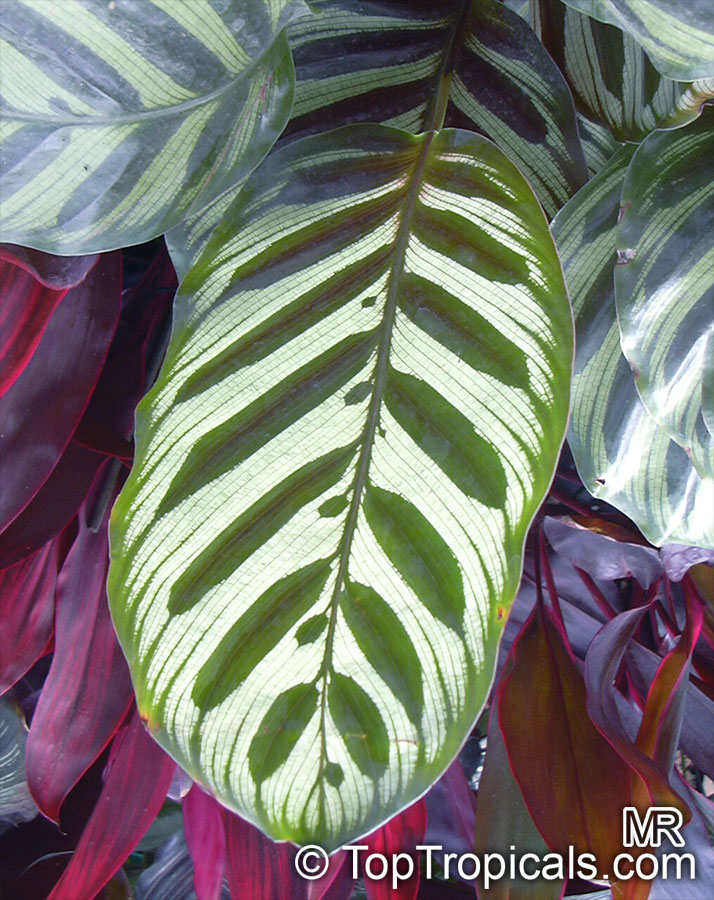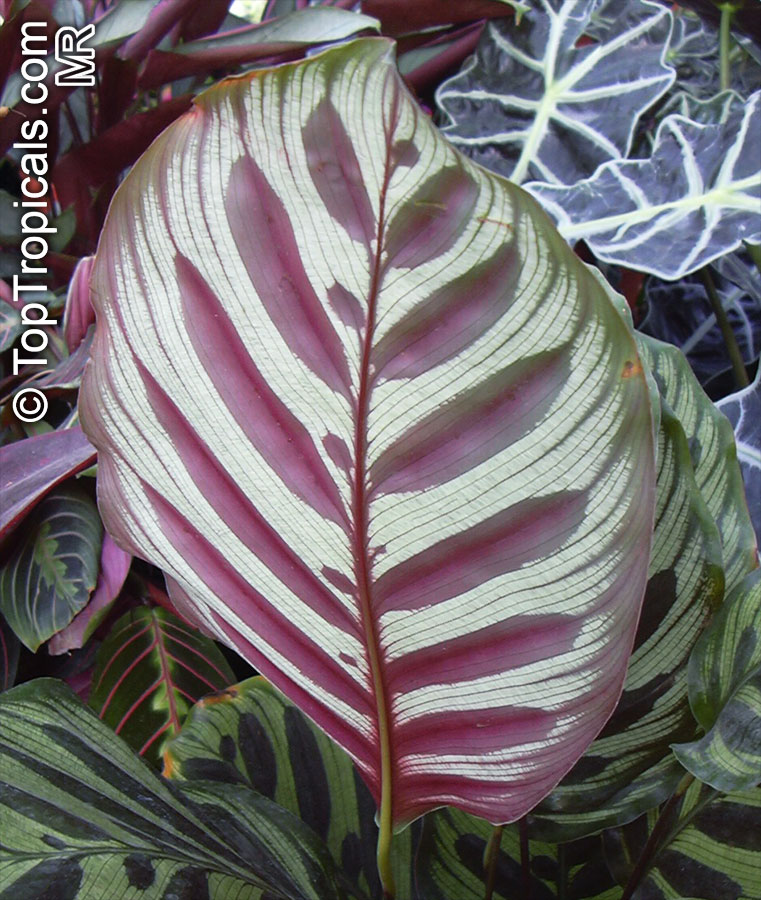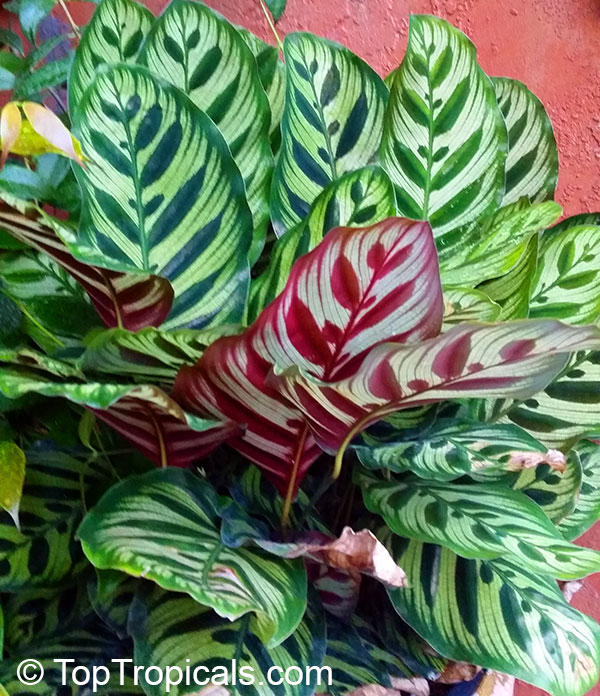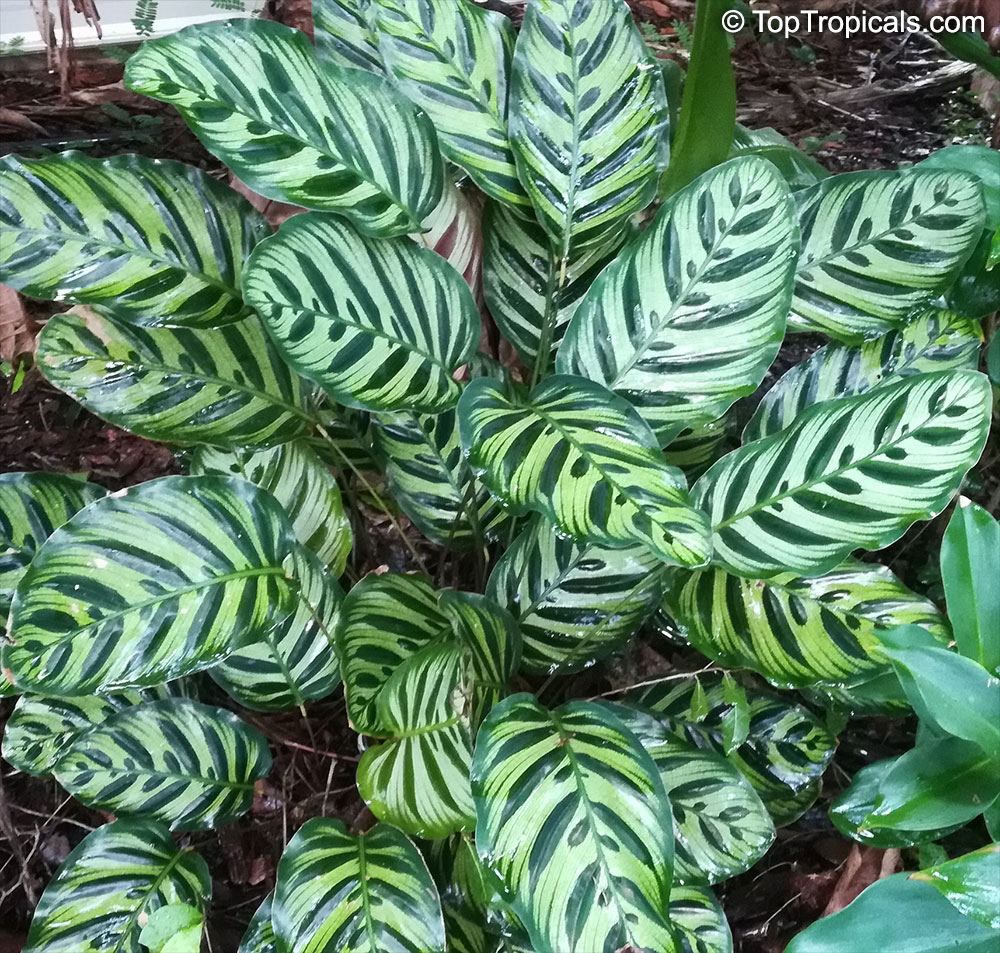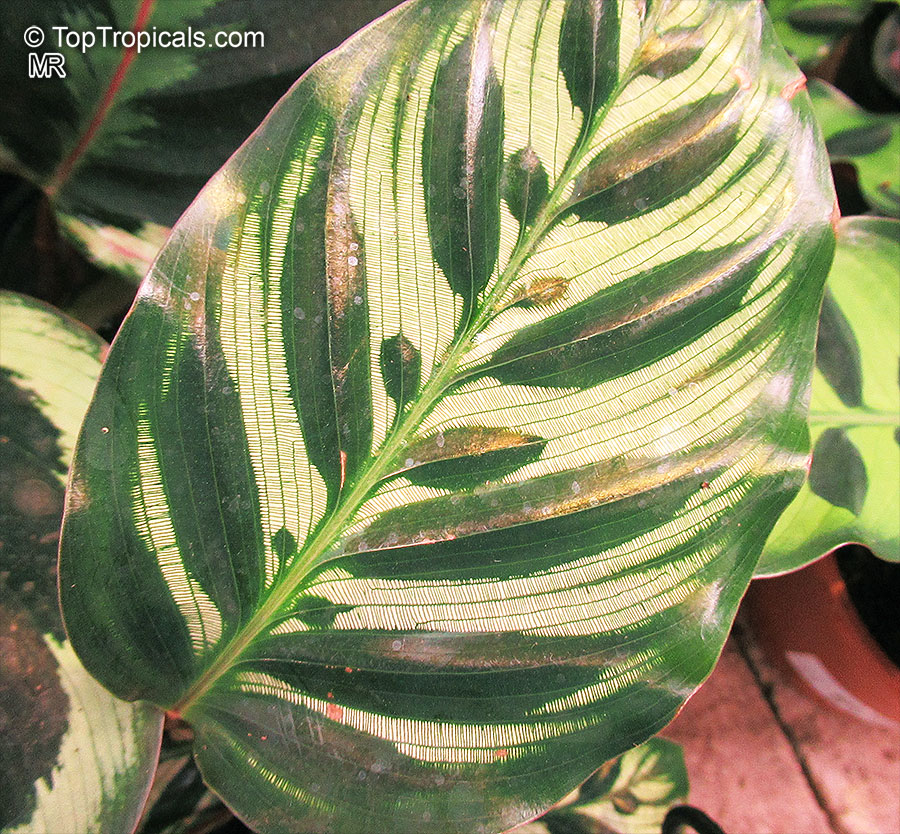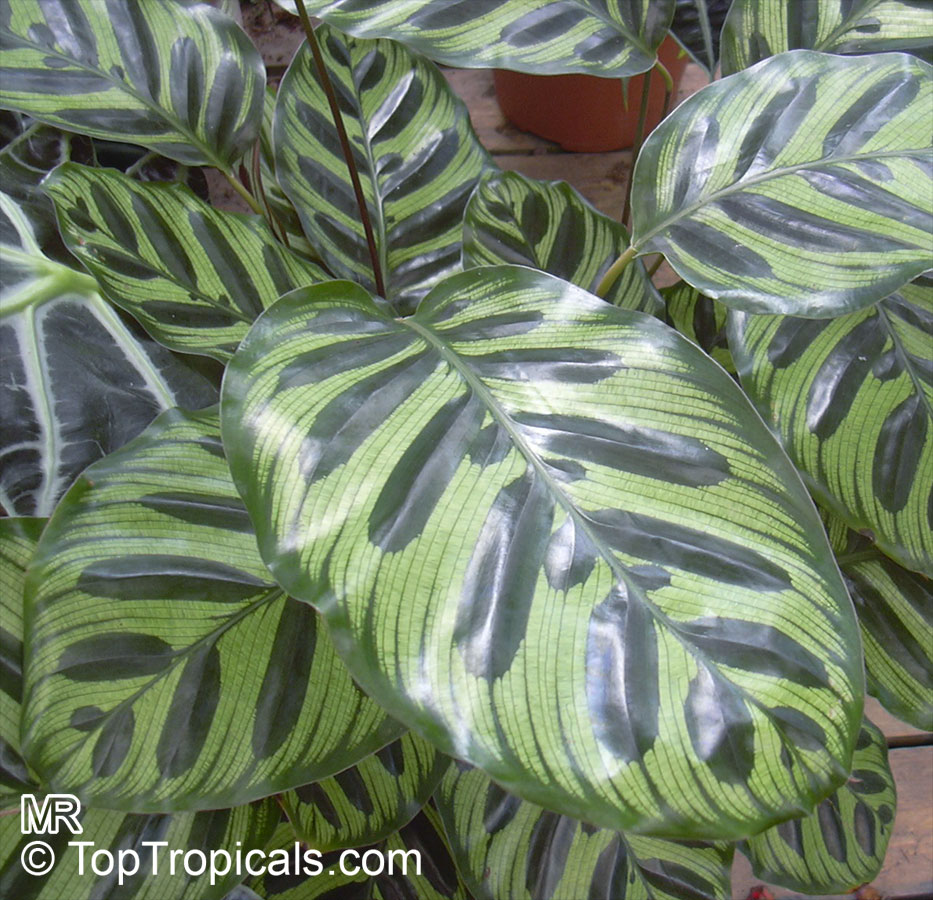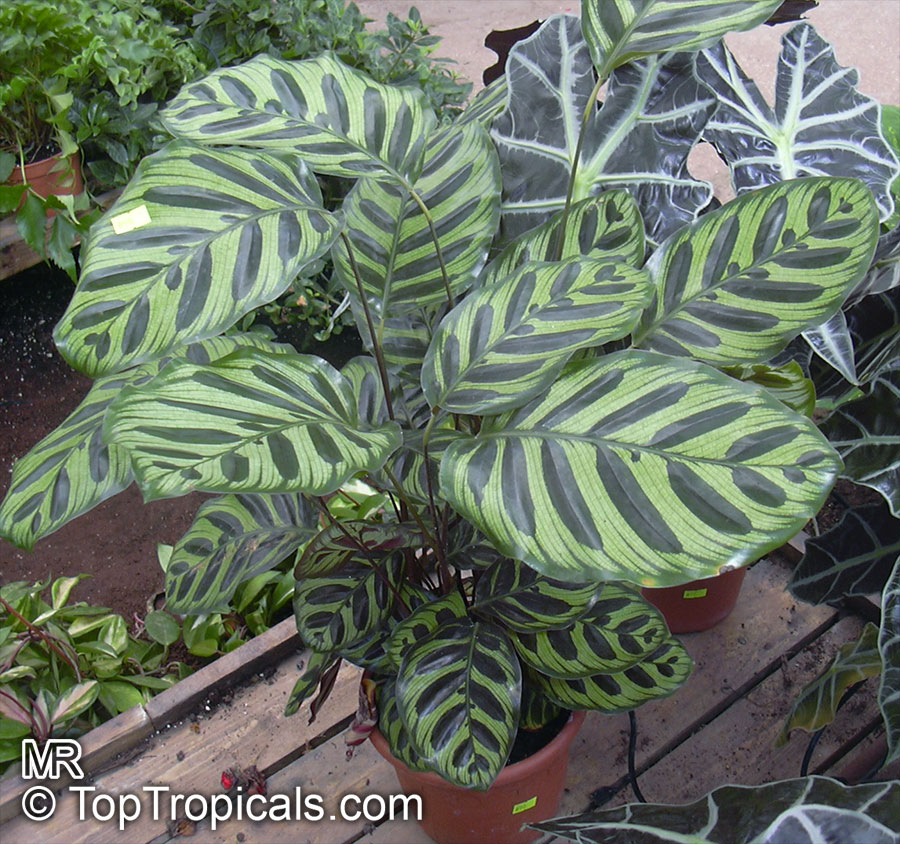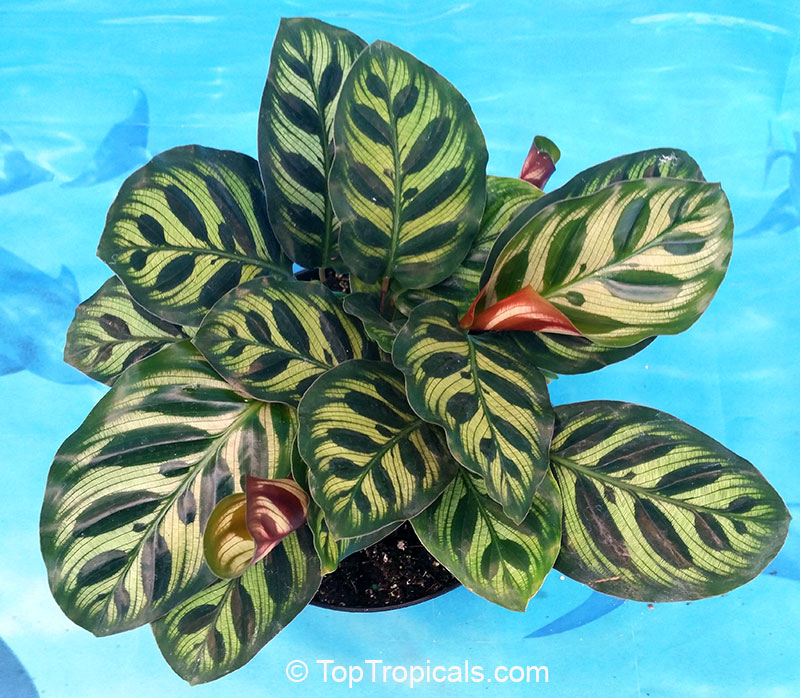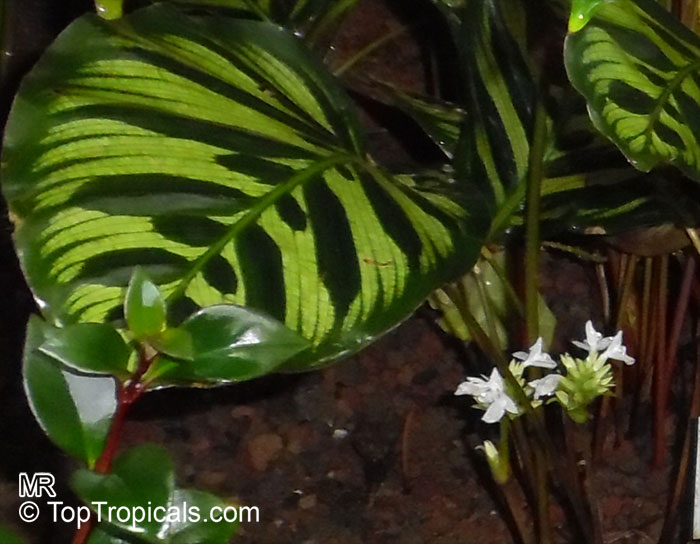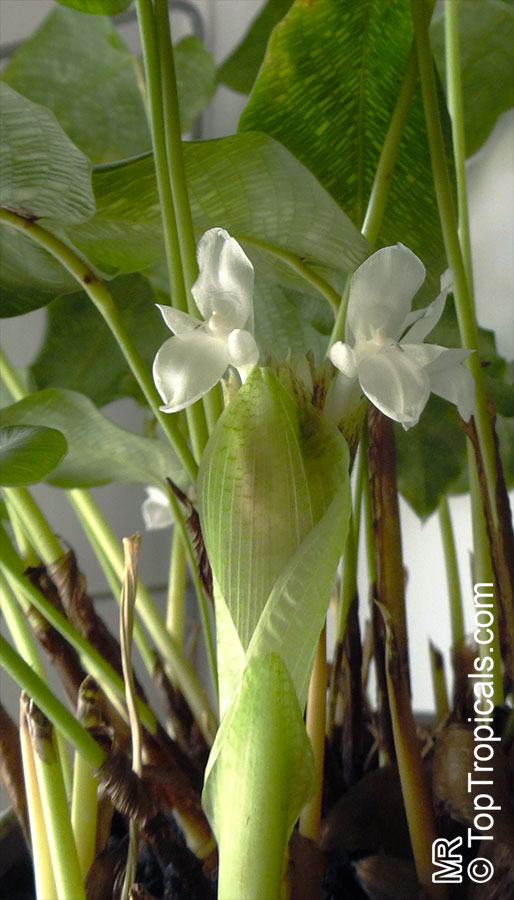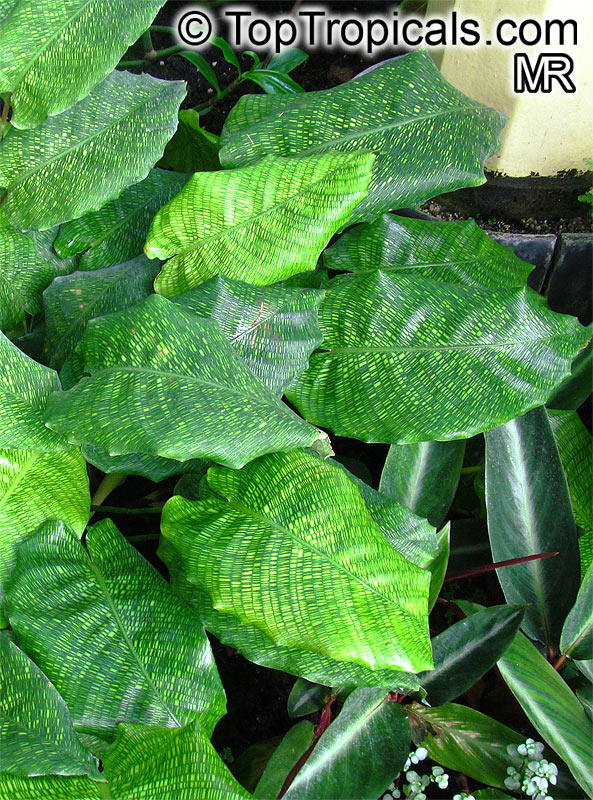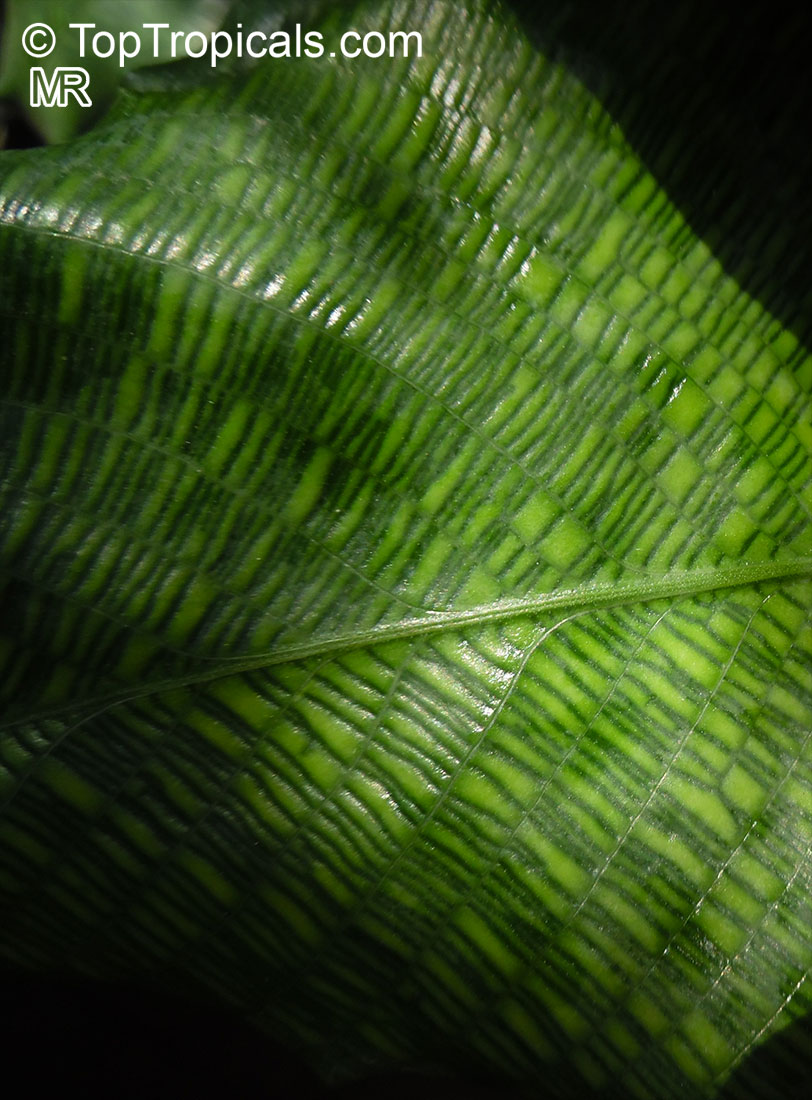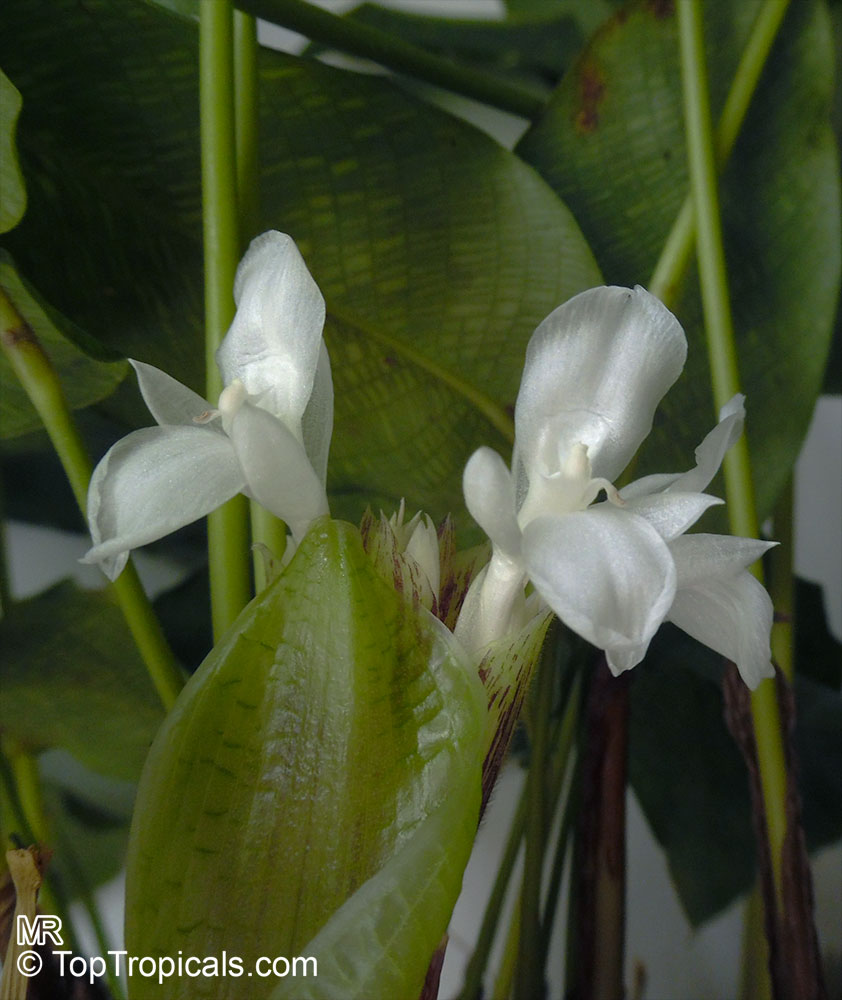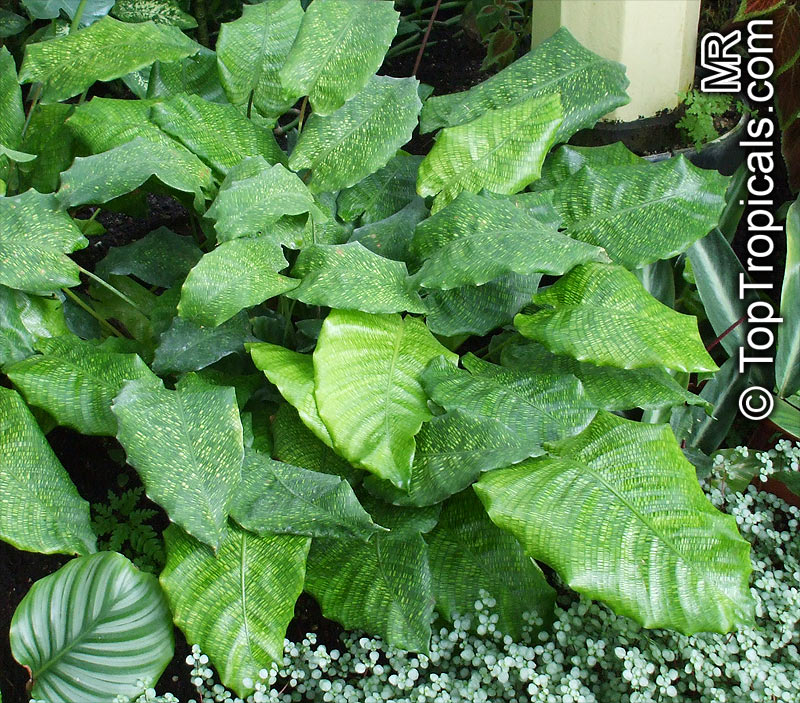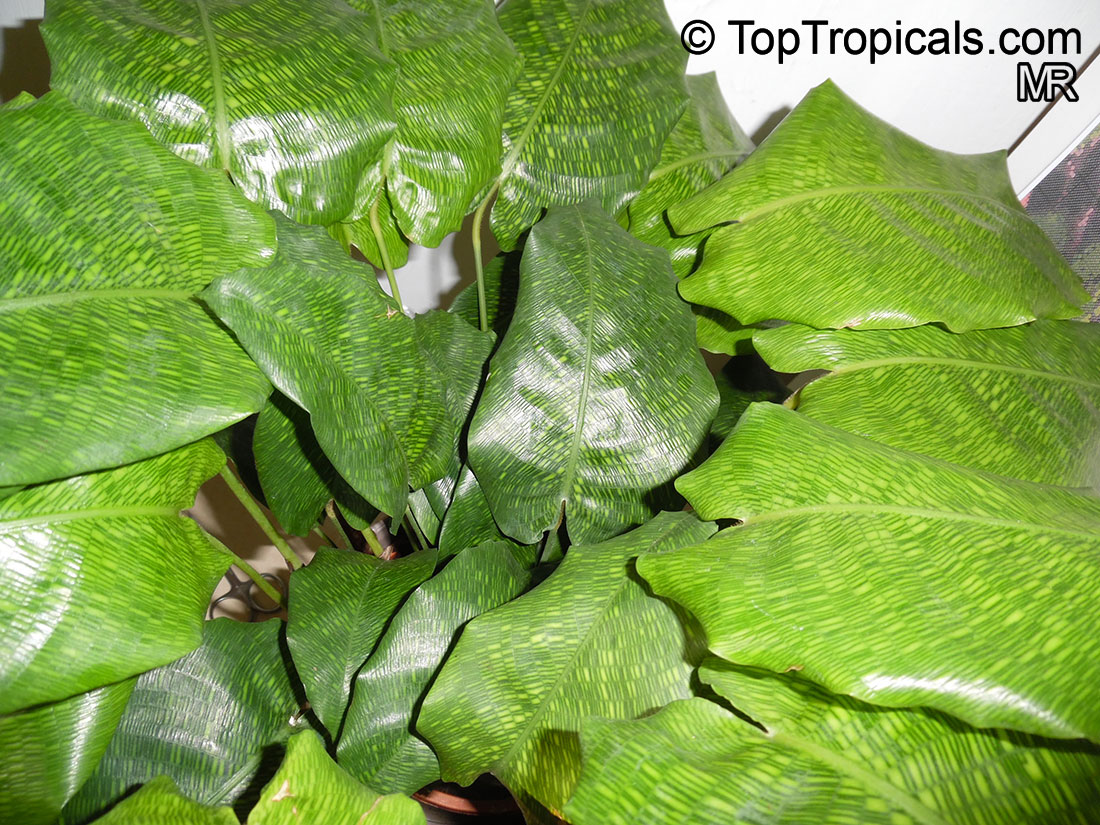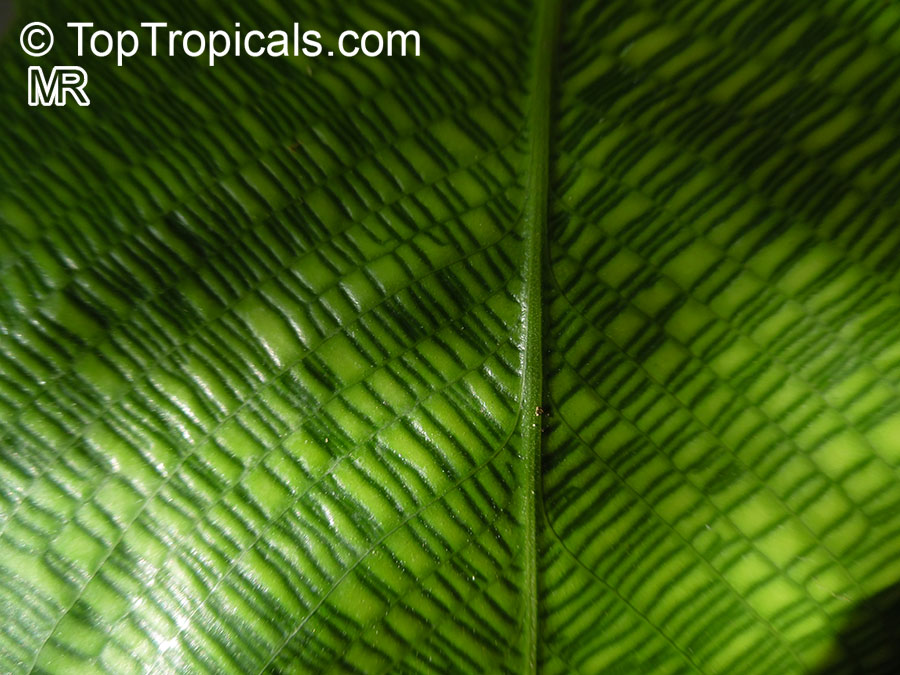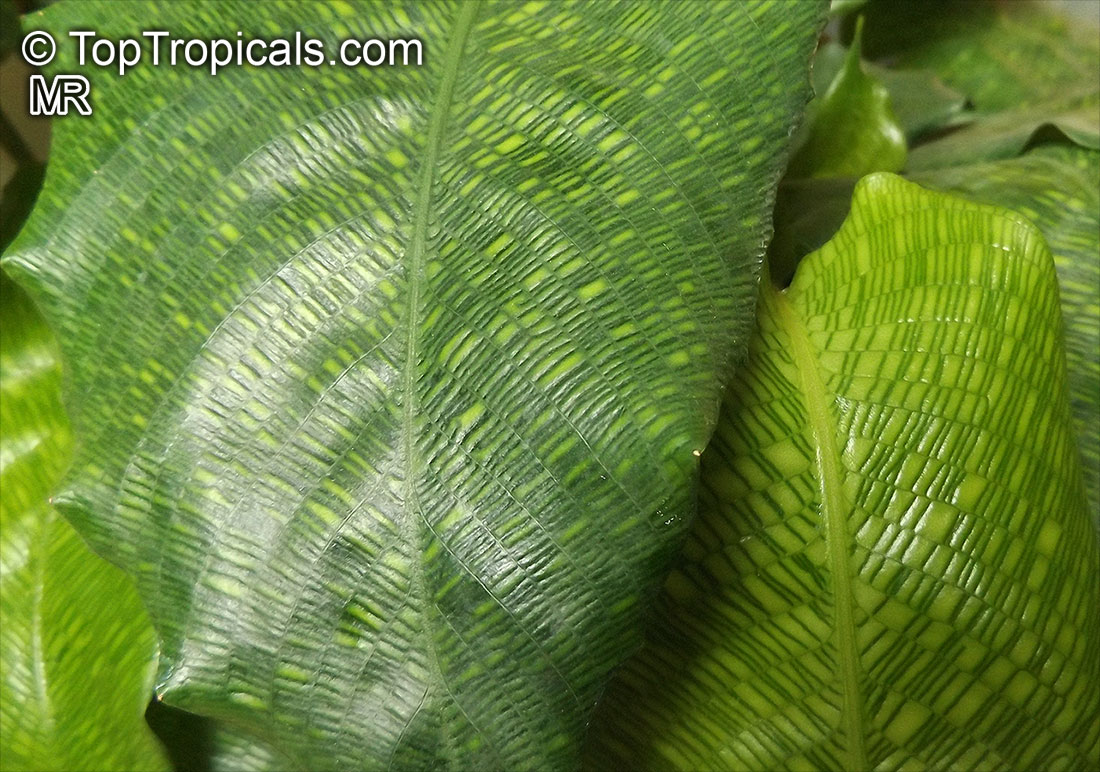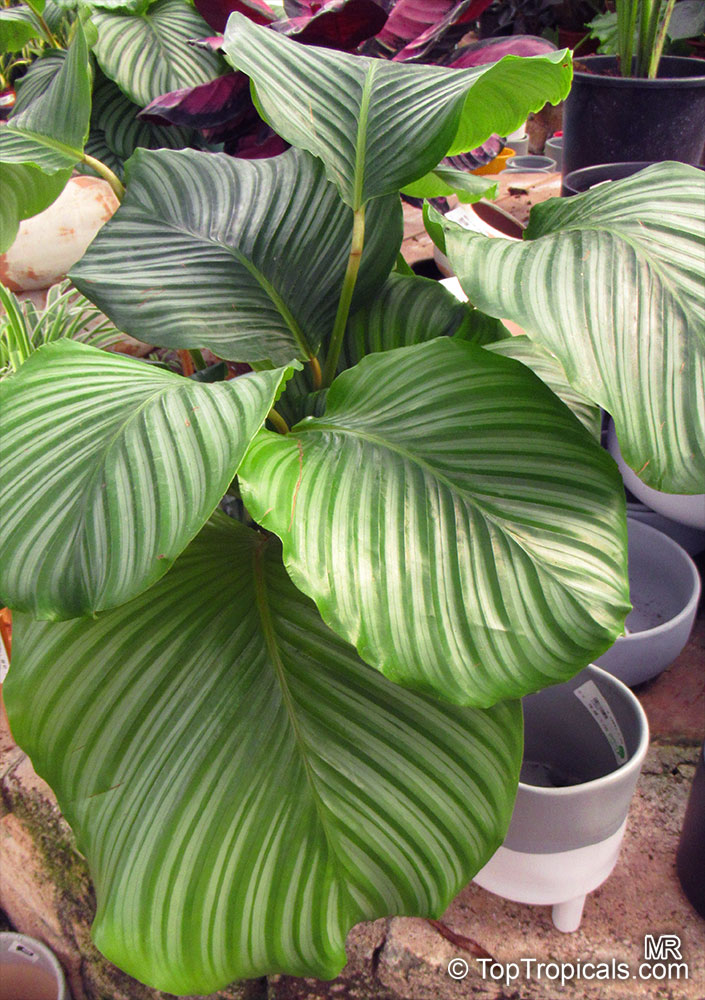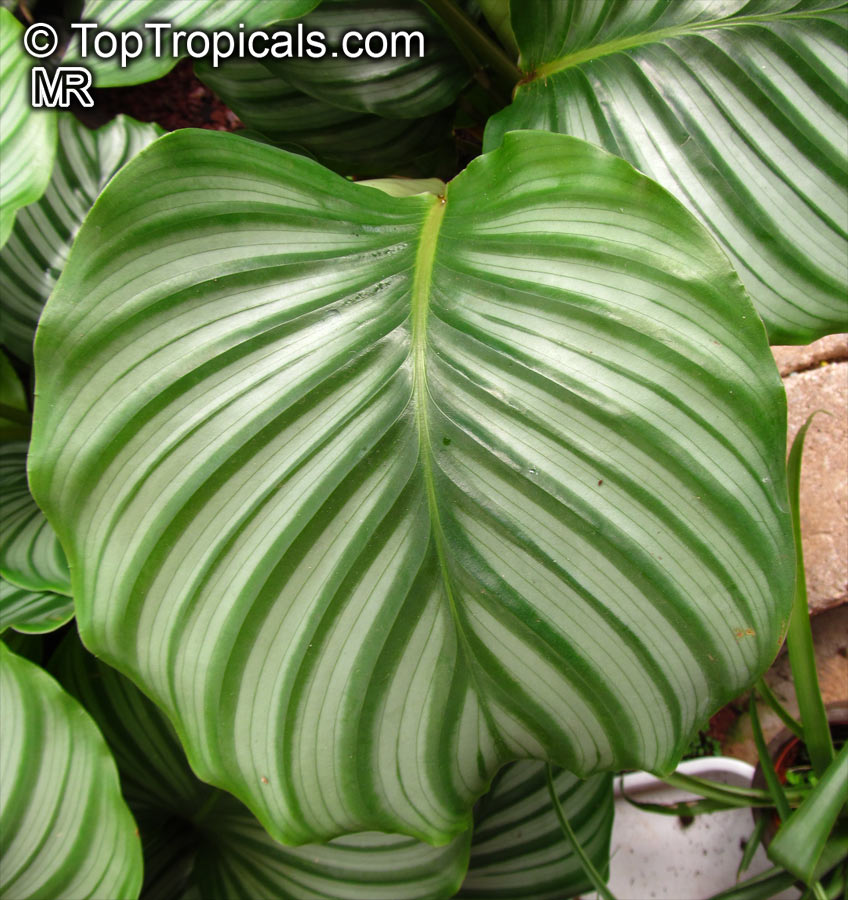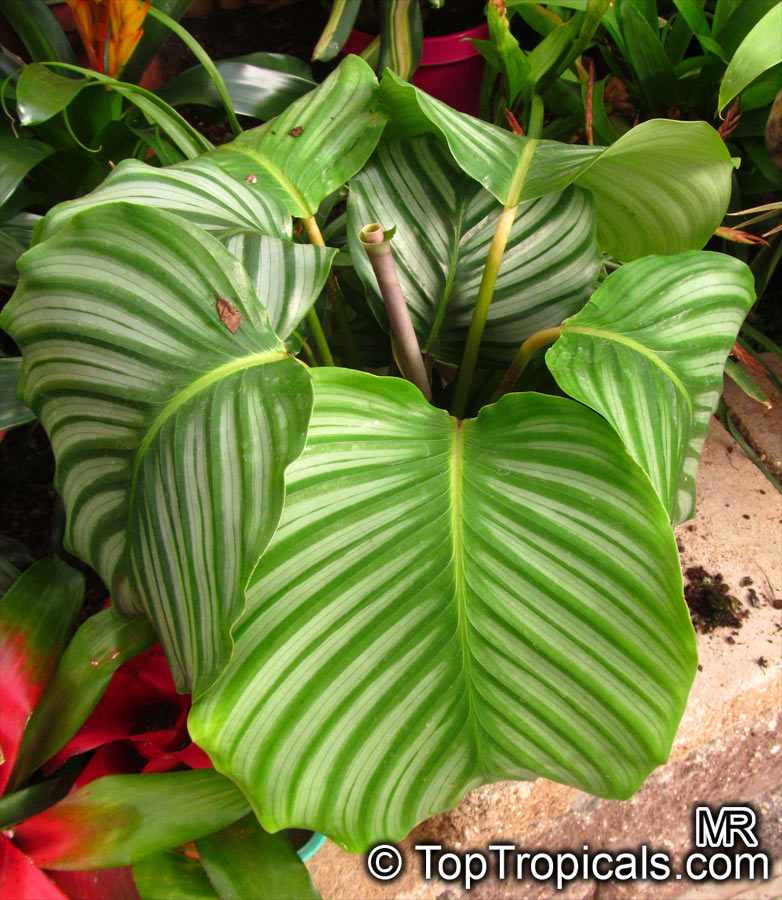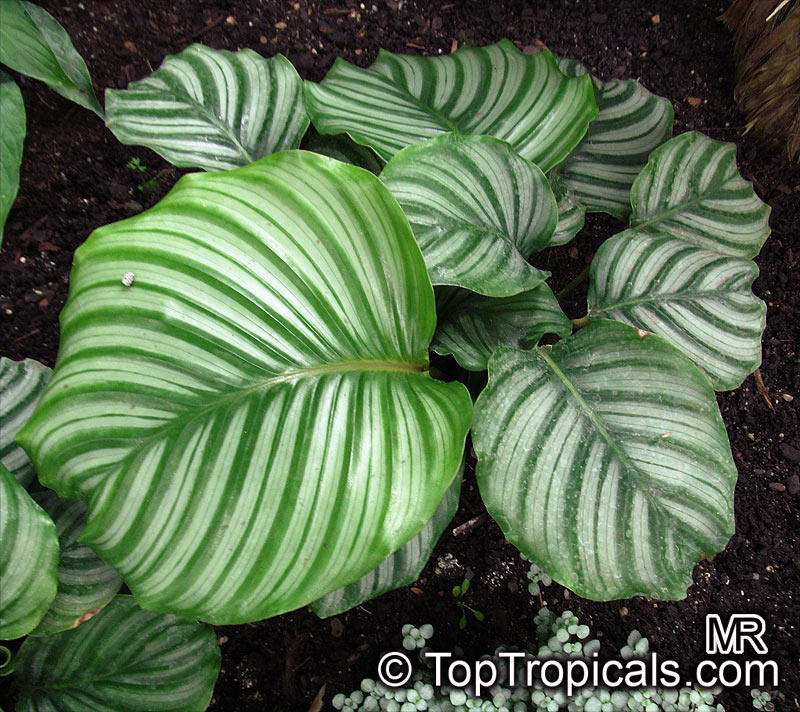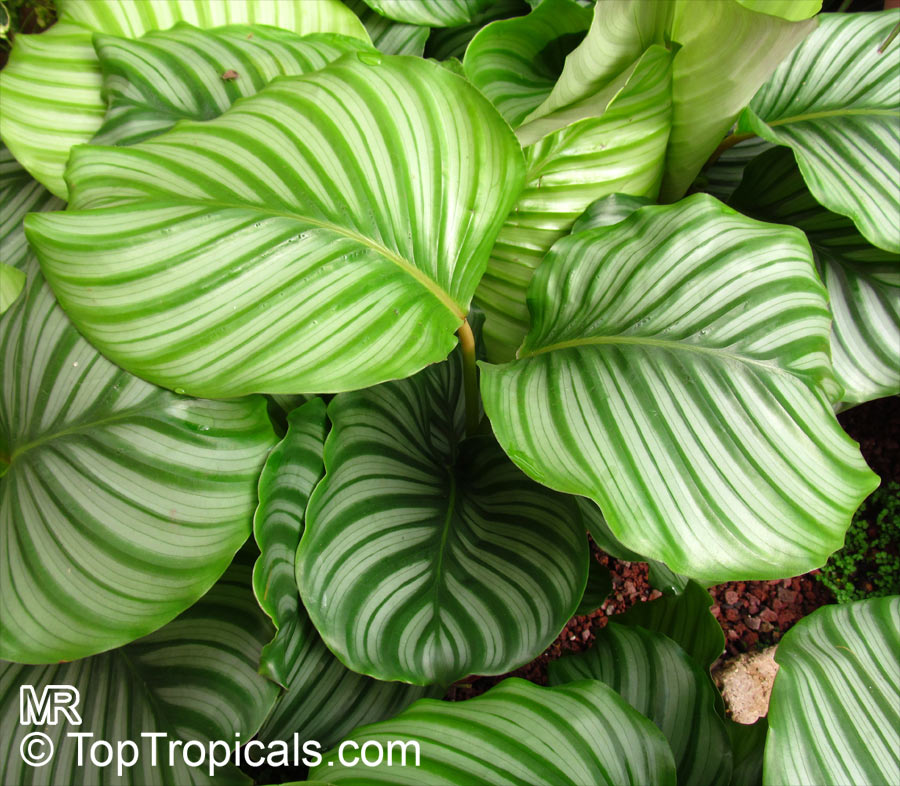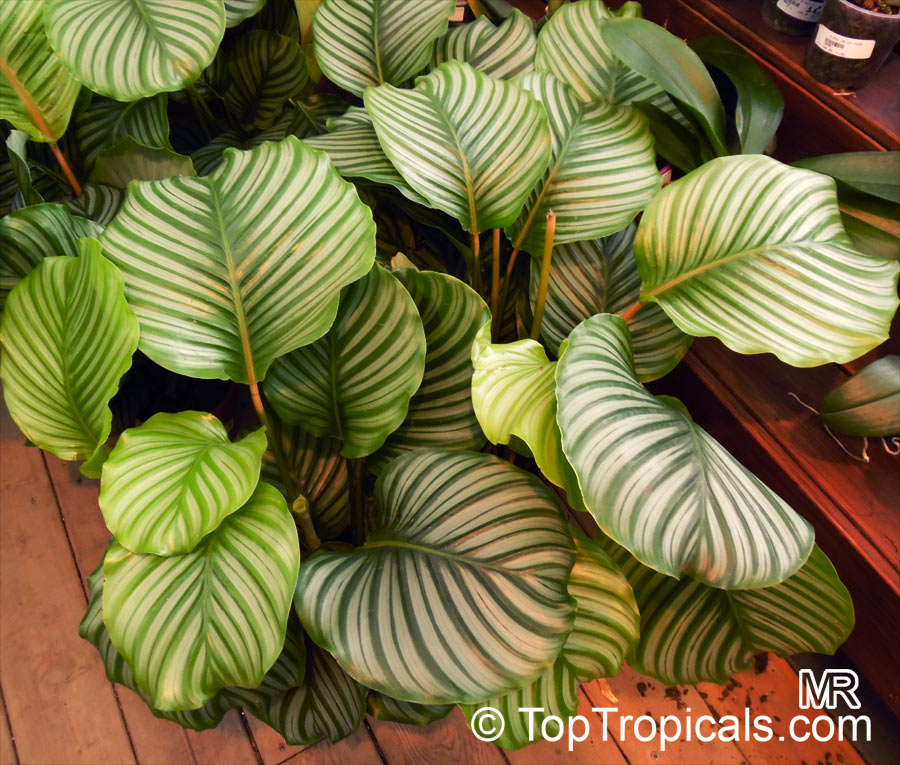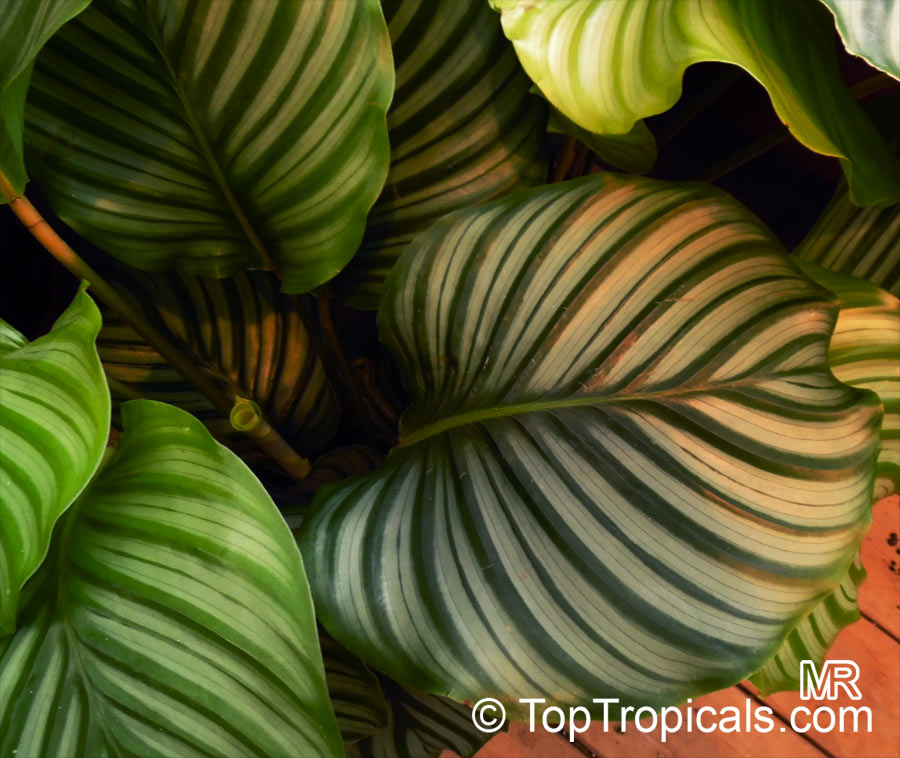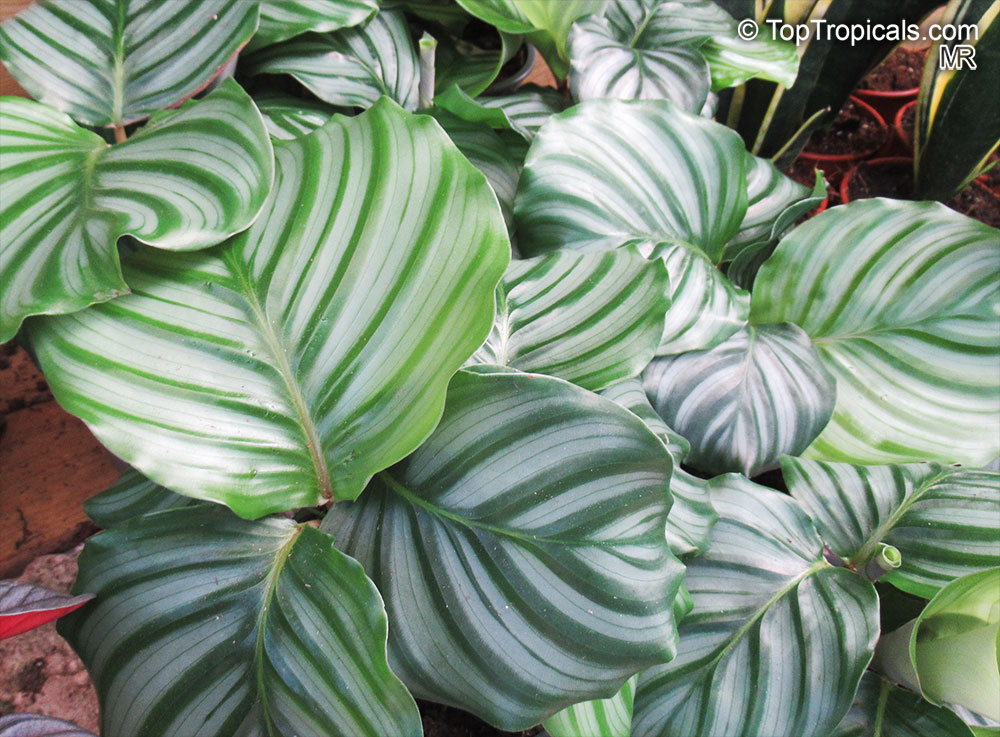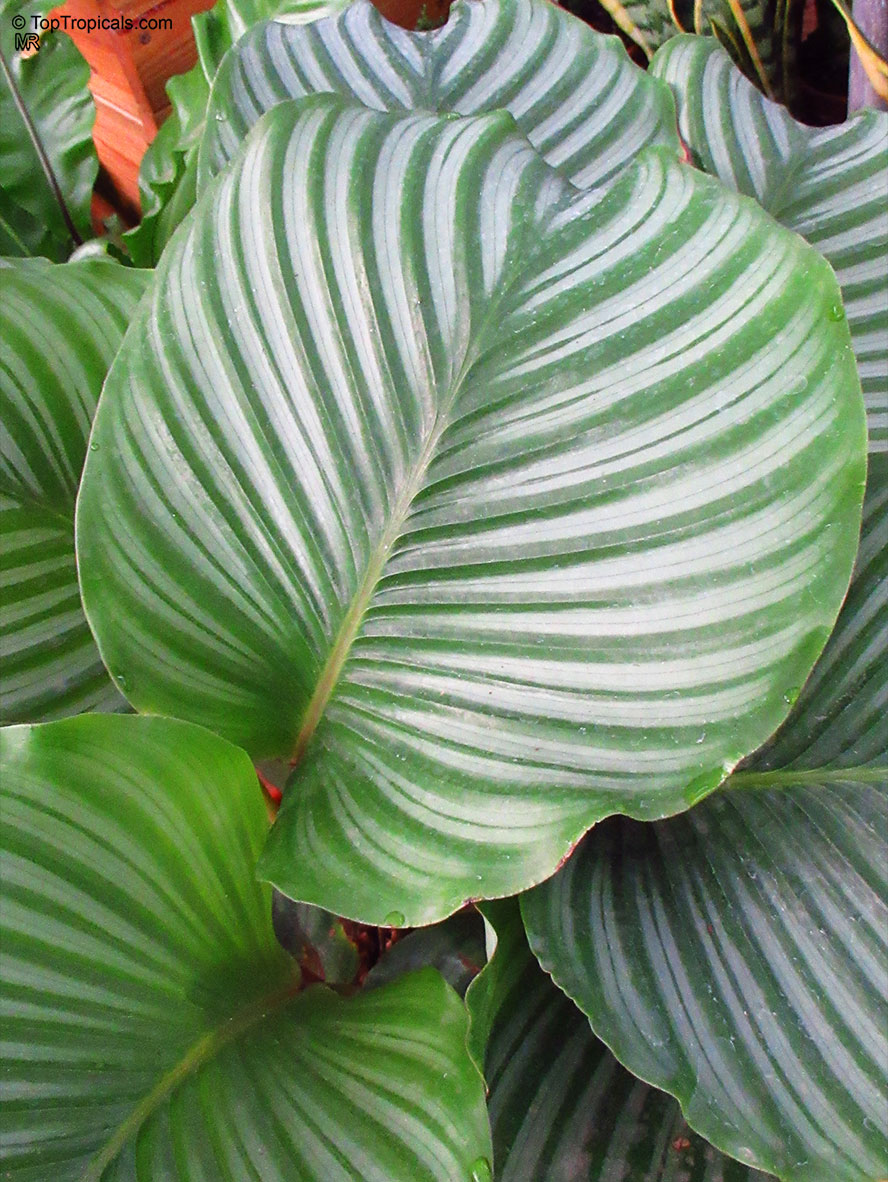Marantaceae - Botanical Family
Top Tropicals Plant Encyclopedia
| Number of plants found: 32 | Next | 
|
Go to page: | 1 | 2 | 3 | 4 |
Botanical names: Calathea altissima, Goeppertia altissima
Common name: Calathea
Family: Marantaceae
Origin: South America
Hardiness: 50°F






In USDA zones below 11, grow as a houseplant or seasonal container specimen.
Botanical name: Calathea burle-marxii
Common name: Ice Blue Calathea
Family: Marantaceae
Origin: Brazil
Hardiness: 35°F







Calathea burle-marxii (Ice Blue Calathea) is an attractive small shrub, native to Brazil, that can reach up to 2-5 feet in height. It boasts an array of ornamental foliage in silver and blue hues, as well as white, off-white, blue, lavender and purple flowers.
This plant requires regular watering and should never be allowed to dry out between waterings. It performs best in shade or semi-shade, and will appreciate some kind of humidity system if kept in dry indoor conditions. Fertilize regularly with a water-soluble fertilizer to keep your Calathea looking its best.
In USDA zones below 10, grow as a houseplant or seasonal container specimen. If you do need to overwinter your Calathea, make sure the pot it is in has good drainage and that you place it in a warm, lightly shaded area. Make sure not to overwater it during this time, as this could lead to root rot. Move the plant back outside during spring and summer.
Botanical name: Calathea crocata
Common name: Eternal flame
Family: Marantaceae
Origin: Brazil
Hardiness: 50°F






Keep Calathea crocata (Eternal flame) out of cold temperatures, as frost will kill it. Grow in a pot and move it indoors during winter in colder climates to prevent frost damage. Calathea crocata is a small shrub, usually between 2-5 ft, and is hardy in USDA Zone11. It is native to Brazil. In USDA zones below 11, grow as a houseplant or seasonal container specimen.
Fertilize bi-monthly with a half-strength dilution of a soluble liquid fertilizer during the summer season.
Water Calathea crocata regularly and more during the warmer summer months. The plant likes a moist soil, however, make sure that the soil does not become soggy. Allow the top inch of soil to dry out between watering and water this small shrub liberally in the growing season. Cut back on water during the cooler winter months when the plant is dormant.
Calathea crocata is an eye-catching plant with long puckered ribbed leaves in an array of colors with maroon undersides. The plant produces orange and yellow flowers that resemble flames. Prune the plant lightly in early spring and again shortly after flowering. Spent flower stalks can be removed as the flowers fade.
Grown as a houseplant, Calathea crocata does best in bright, indirect light and high humidity. The days will be brighter with the addition of a Calathea crocata in any home or garden.
Botanical name: Calathea crotalifera
Common names: Rattlesnake Plant, Rattle Shaker, Rattlesnake Ginger, Yellow Rattleshaker
Family: Marantaceae
Origin: Central and South America
Hardiness: 40°F





The unusual inflorescences are upright, shaped like a rattlesnake's rattle, up to 10 inches (25 cm) long, and consist of stacked leathery floral bracts with small, yellow or yellow-orange flowers peeking out at the edges. The relatively inconspicuous actual flowers are tubular and have 3 unequal lobes. In USDA zones below 10, grow as a houseplant or seasonal container specimen.
Botanical names: Calathea lietzei, Goeppertia lietzei
Common name: Calathea
Family: Marantaceae
Origin: Brazil
Hardiness: 50°F





Calathea lietzei is a compact tropical plant known for its striking patterned foliage. It typically grows up to 2 feet tall and prefers warm, humid conditions with partial shade. The soil should be consistently moist but well-drained, and regular watering is essential for healthy growth.
This plant can be grown outdoors year-round only in USDA Zone 11, where temperatures stay above 50F.
In cooler zones, Calathea lietzei should be grown in a container. Place the pot in bright, indirect light, sheltered from wind, and bring it indoors before temperatures drop. With the right care, Calathea lietzei makes a beautiful addition to indoor spaces or shaded tropical gardens.
Calathea lietzei 'White Fusion' (Goeppertia lietzei 'White Fusion') is a stunning variegated cultivar prized for its marbled leaves that combine pure white with several shades of green, ranging from deep emerald to light mint. The unique foliage pattern makes it a striking decorative plant for indoor settings.
Botanical names: Calathea loeseneri, Goeppertia loeseneri
Common name: Brazilian Star Calathea
Family: Marantaceae
Origin: Peru, Brazil, Colombia, Ecuador and Bolivia
Hardiness: 50°F








This Brazilian Calathea is one of the very few with showy flowers. The large leaves are quite attractive and they remind of a peacock ginger (Kaempferia). The leaves are light green with a white midrib. The white/pinkish flowers are 3" produced on long stems. The blooms are very showy above the foliage. This is a rarely offered plant. Makes an excellent container plant for shady locations.
In USDA zones below 11, grow as a houseplant or seasonal container specimen.
Botanical name: Calathea lutea
Common name: Cigar Calathea
Family: Marantaceae
Origin: Tropical America
Hardiness: 40°F






Calathea lutea can grow to a height of 2.5 m and produces cigar-shaped bracts. The paddle-shaped leaves have reflective silver undersides. The most common cultivar found locally produces brownish bracts.
In USDA zones below 10, grow as a houseplant or seasonal container specimen.
Botanical names: Calathea makoyana, Goeppertia makoyana, Maranta makoyana
Common name: Peacock plant
Family: Marantaceae
Origin: Central and South America and the Caribbean





Mostly grown in gardens for the handsomely patterned foliage. Calathea prefers moist, shady, jungle-like conditions in a garden and is also often grown as potted specimens. When it is used as a house plant, the leaves should be sprayed with water several times a week. Propagation is by root division. Water with soft water. Keep uniform high humidity and temperature. Look best when grouped with other foliage plants. Can be used in a bottle garden or terrarium. This plant requires very specific growing conditions in order to thrive. Place in a warm, shady position i.e. one that never receives direct or indirect sun. Feed with a liquid fertilizer every two weeks during Spring and Summer and once a month during Autumn and Winter. Stand on a tray filled with water and pebbles to increase humidity. Water plentifully. Never allow to dry out - keep the potting mixture moist at all times. Repot every Spring using a mix of two thirds potting mixture and one third leaf mould or peat. Once the plant has been potted on to a fifteen centimetre pot , it is only necessary to replace the top layer of soil.
See Article - How to grow Calathea indoors.
See Article - How to grow Calathea indoors.
Recommended Fertilizer: SUNSHINE Robusta - Rapid Growth Booster
Botanical names: Calathea musaica, Goeppertia kegeljanii
Common name: Network Calathea
Family: Marantaceae
Origin: Brazil
Hardiness: 50°F






Its chartreuse leaves are characterized by an incredibly intricate web-like pattern of dark green lines that intersect at right angles, creating tiny rectangular sections.
In USDA zones below 11, grow as a houseplant or seasonal container specimen.
Botanical names: Calathea orbifolia, Goeppertia orbifolia
Common name: Peacock Plant
Family: Marantaceae
Origin: Tropical America, West Indies
Hardiness: 50°F




It has a small, shrub-like habit, growing no more than 2-5 feet tall and wide, with a bushy form.
Calathea orbifolia is best grown in semi-shade to full shade, and in well-draining soil that is kept evenly moist. The plant requires regular watering and should not be allowed to dry out. If grown indoors it should be kept away from direct sunlight, and a humidity tray or humidifier is highly recommended. It is an ornamental foliage plant and does not need to be fed extra fertilizer.
In USDA zones below 11, grow as a houseplant or seasonal container specimen. The soil should be kept moist and the plant should not be allowed to dry out. It is important to ensure that the pot has adequate drainage, as the plant will not tolerate waterlogging.
Calathea orbifolia is a beautiful plant and makes a great addition to any home or garden. With the proper care and attention, it can bring a touch of the tropics to any indoor or outdoor space.
| Next |  |
Use link to repeat this search:
https://toptropicals.com/cgi-bin/garden_catalog/cat.cgi?search_op=and&keyword_op=and&language=e&family=Marantaceae&number=10
&no_change_lang=1&user=tt&sale=1&first=0
